People often skip breakfast due to being too busy with work, but this inadvertently becomes a bad habit that needs to be eliminated immediately. On this occasion, TasteVN will reveal to you the recipe for a delicious beverage that is simple for you to showcase your skills. Let’s get started in the kitchen and immediately prepare 3 ways to cook pork hủ tiếu!
1. Pork hủ tiếu
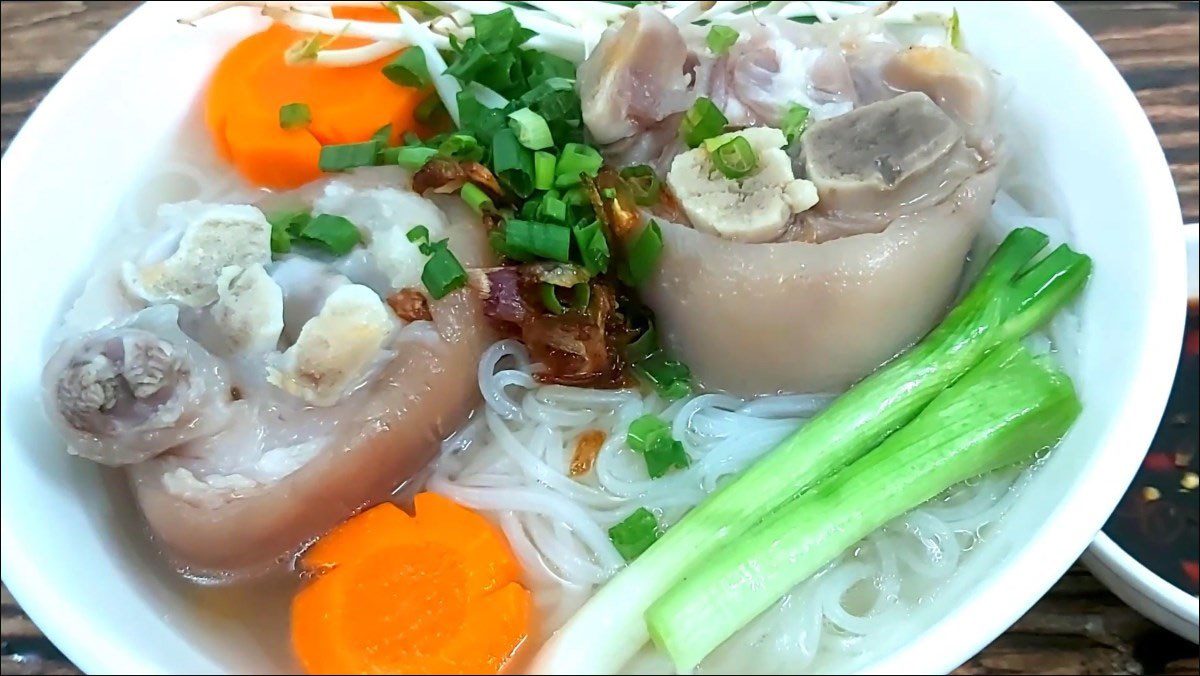
-
Preparation
20 minutes
-
Cooking
1 hour 45 minutes
-
Difficulty
Easy
Ingredients for Pork Hủ Tiếu For 4 people
Dry hủ tiếu 300 gr Pork leg 1 kg White radish 500 gr (2 pieces) Carrot 250 gr (1 piece) Onion 1 piece Green onion 2 stalks Star anise 3 pieces Cinnamon 2 pieces Common spices a little (Seasoning/ salt/ sugar/ monosodium glutamate)
Ingredient Image
-800x450.jpg)
How to prepare Pork Leg Noodle Soup
-
Prepare the ingredients
First, for the white radish and carrot, use a peeler to peel the skin. Then, rinse them 1 – 2 times with water to clean, let them drain, and then use a knife to cut them into bite-sized pieces.
For the green onions, remove the roots, wash them clean, let them drain, and then chop finely. As for the onion, peel it and cut it into wedges.
Finally, place a pan on the stove with star anise and cinnamon sticks and roast them on low heat for about 5 minutes. When you smell the fragrance, turn off the heat and transfer to a bowl.
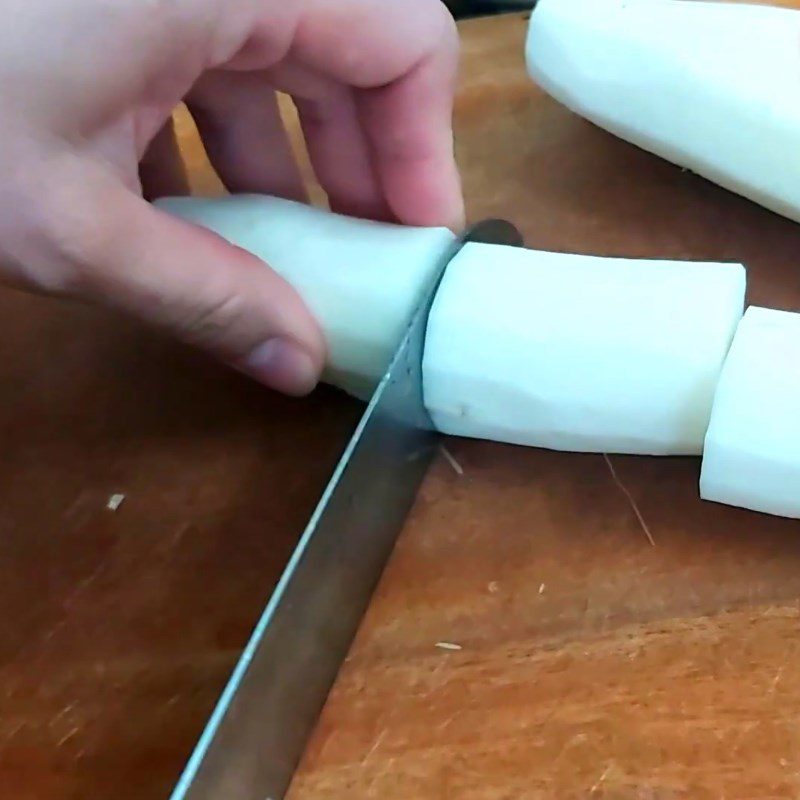
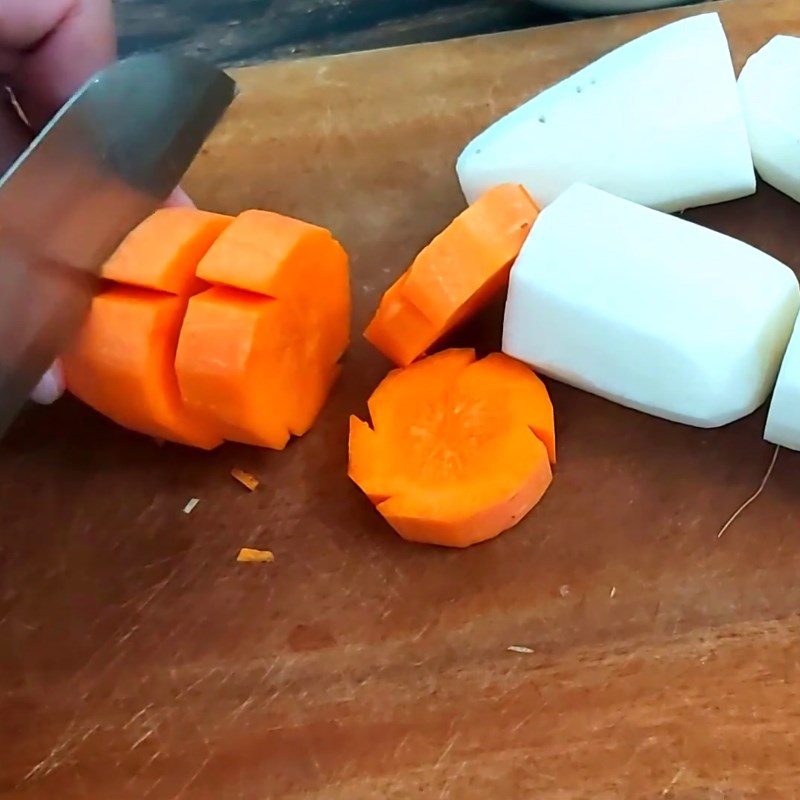
-
Prepare and blanch the pork leg
For 1kg of pork leg, rub a little salt on the surface of the meat for 3 – 5 minutes, then wash it a few times with water to clean, let it drain, and cut it into bite-sized pieces.
At the same time, place a pot on the stove with 500ml of water on high heat. When the water boils, add all the pork that has just been prepared and blanch for 5 – 7 minutes.
When you see the pork leg firming up a bit, turn off the heat and transfer it to a bowl.
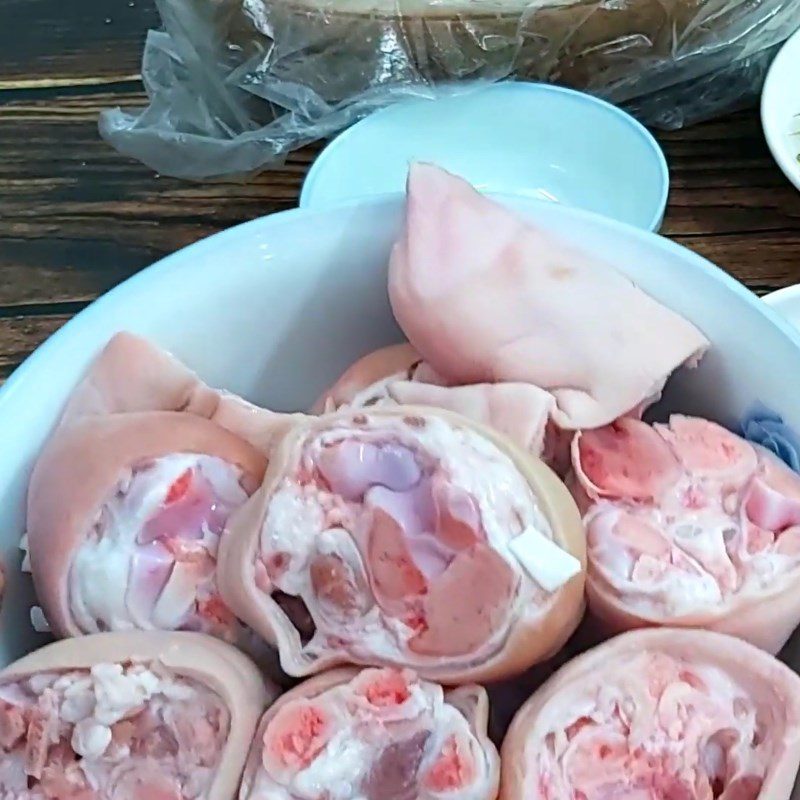
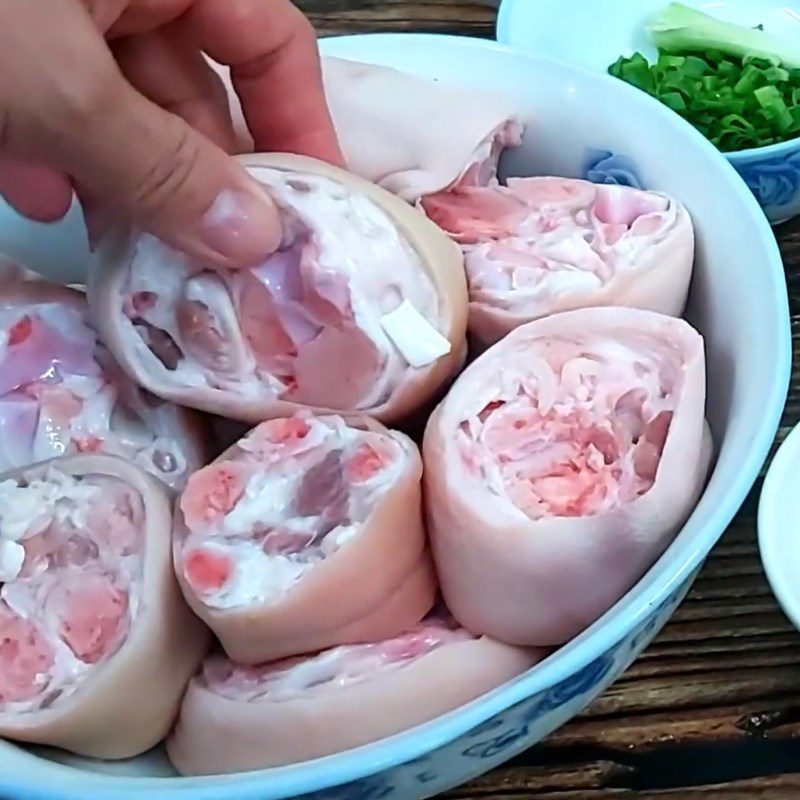

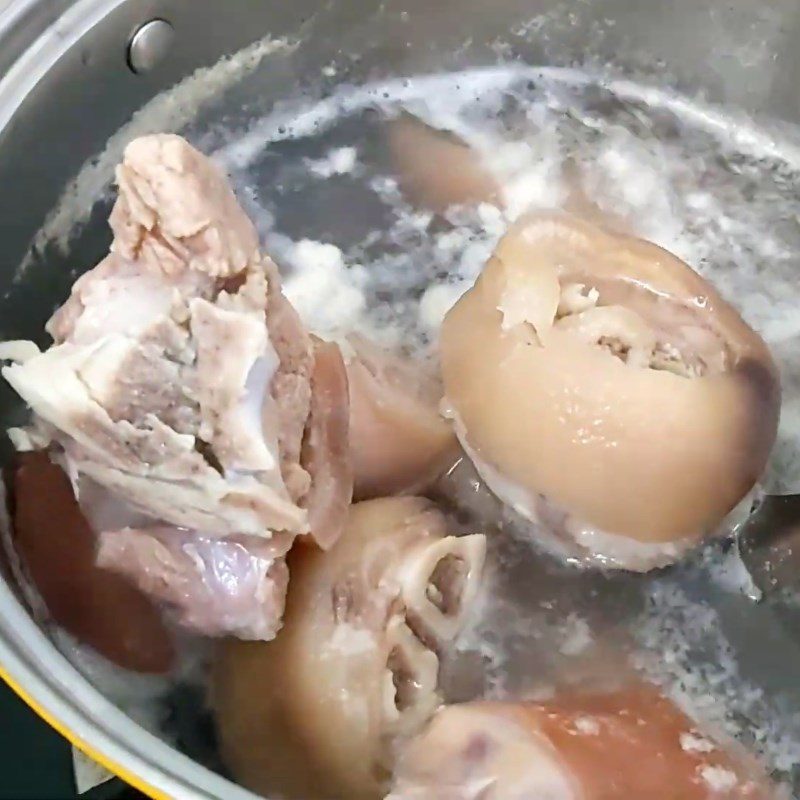
-
Cook the broth
Next, place another pot on the stove with 1.2 liters of water, 1 onion, and the star anise and cinnamon that have been roasted, then cook over medium heat for about 10 minutes.
When the water is slightly bubbling, add all the blanched pork leg, 1 carrot, and 2 white radishes, and continue to cook for another 25 – 30 minutes.
When the ingredients are soft, remove the star anise, cinnamon, white radish, and onion.
At the same time, season with 4 teaspoons of salt, 1/2 tablespoon of sugar, 2 teaspoons of seasoning powder, and 1 teaspoon of monosodium glutamate, using ladle to stir well so that the seasonings are dissolved together.
When the broth comes to a boil again, taste and adjust the seasonings, then turn off the heat.
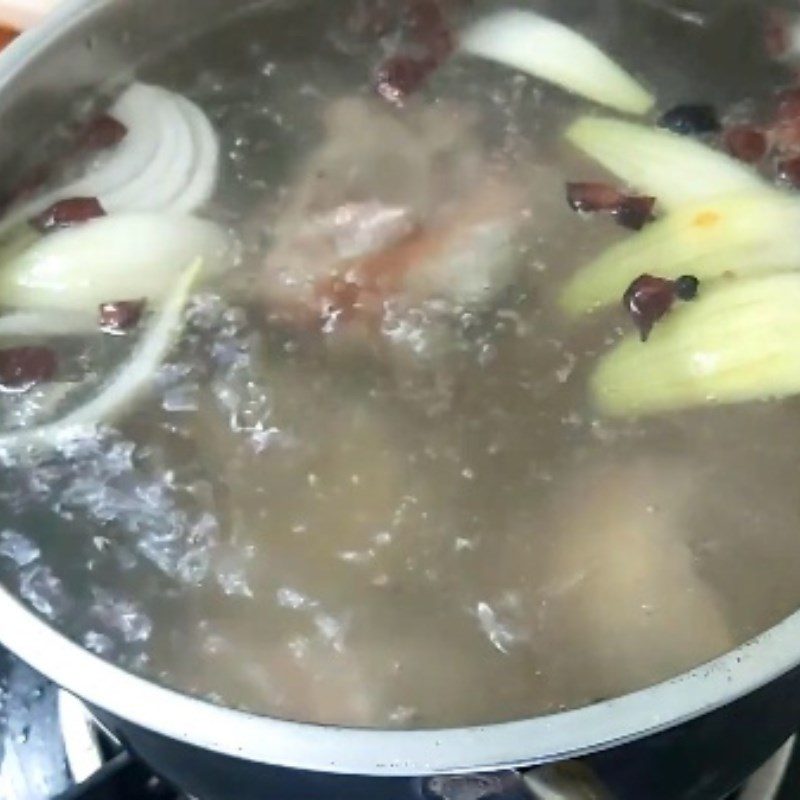
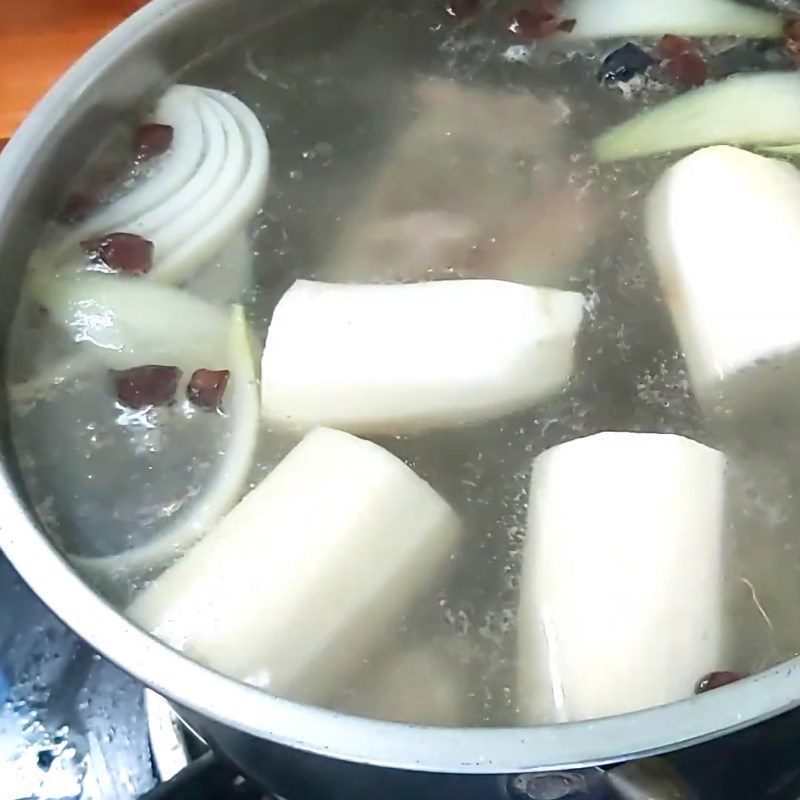

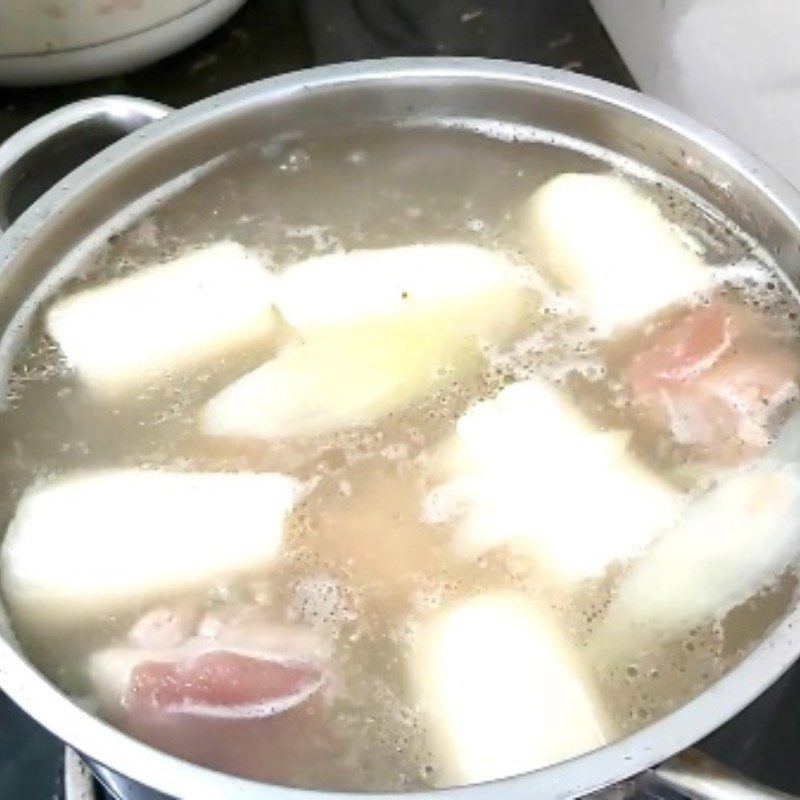
-
Blanching noodles
At the same time, place another pot on the stove with 500ml of water over high heat. When the water boils, add all the noodles and blanch for about 3 – 5 minutes. Once the noodles are soft, turn off the heat and take them out into a bowl.
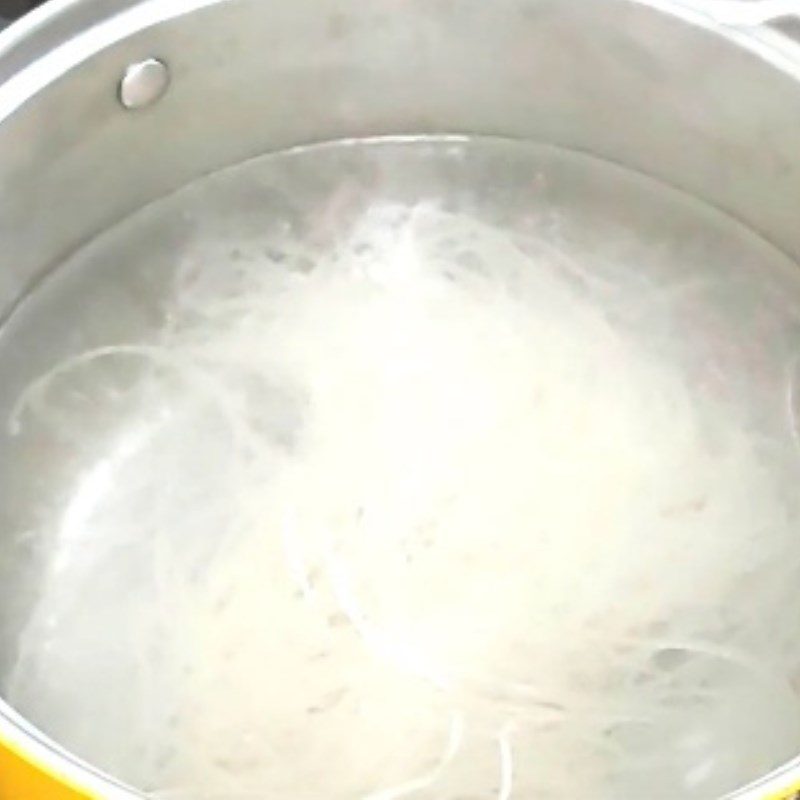

-
Completion
Finally, you just need to take a bowl and gradually add a little noodles, pork leg, carrots, broth, and a bit of green onion, then enjoy right away!
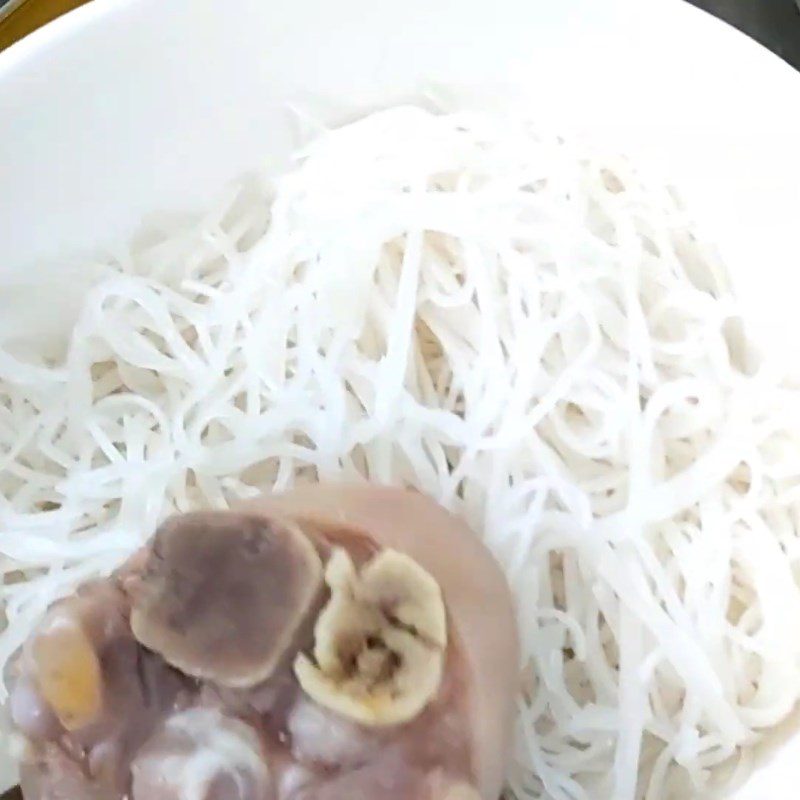
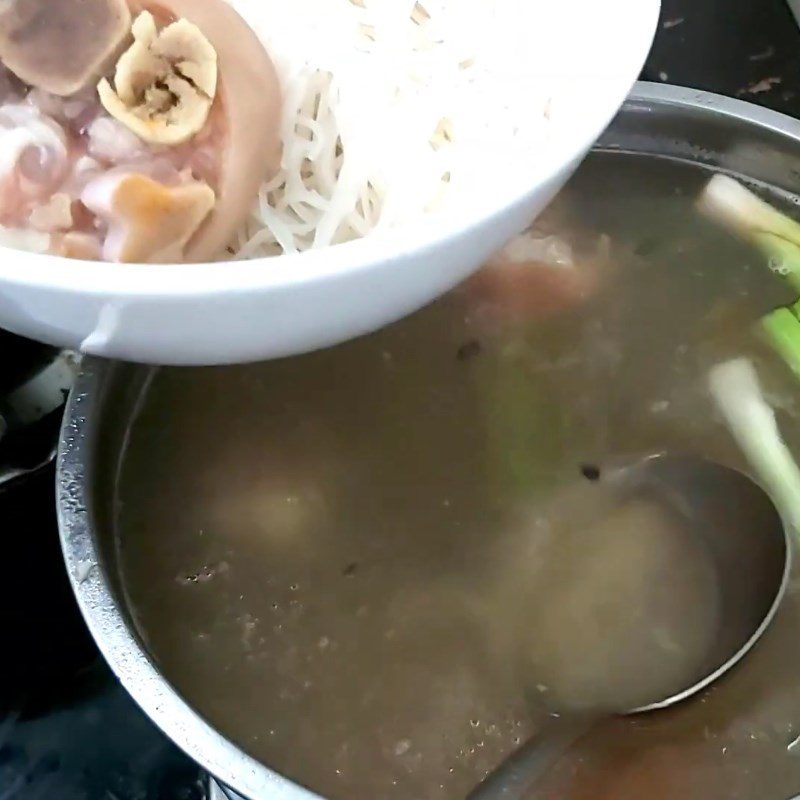
-
Final product
With just a few simple tweaks, you can create a hot, delicious bowl of pork leg noodles that is absolutely irresistible!
A bowl of noodles with hot, sweet, rich broth is truly hard to resist, and the chewy noodles combined with the tender pork leg and delicious carrots is simply amazing!
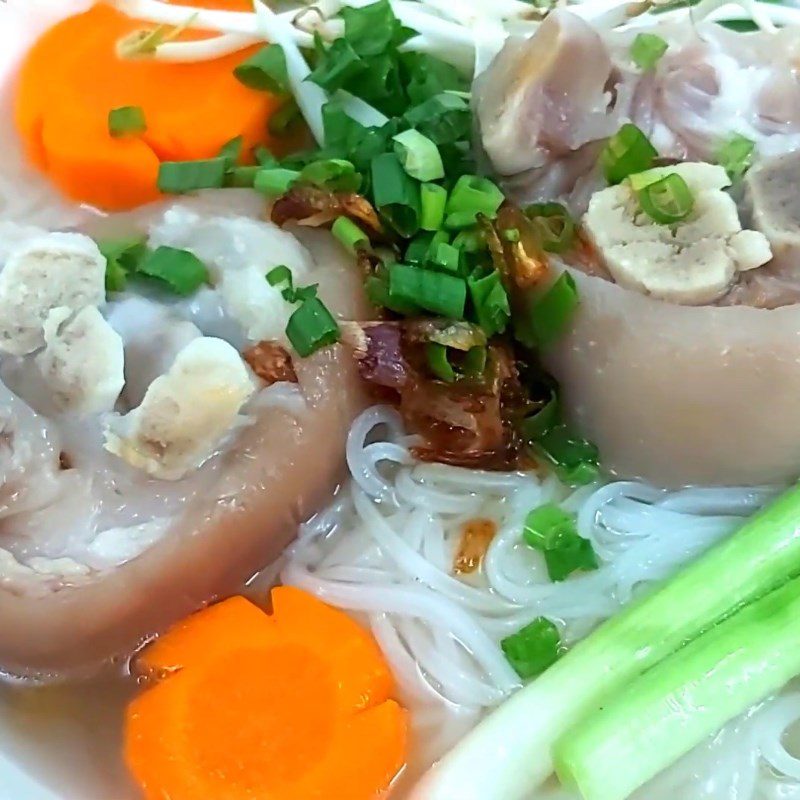
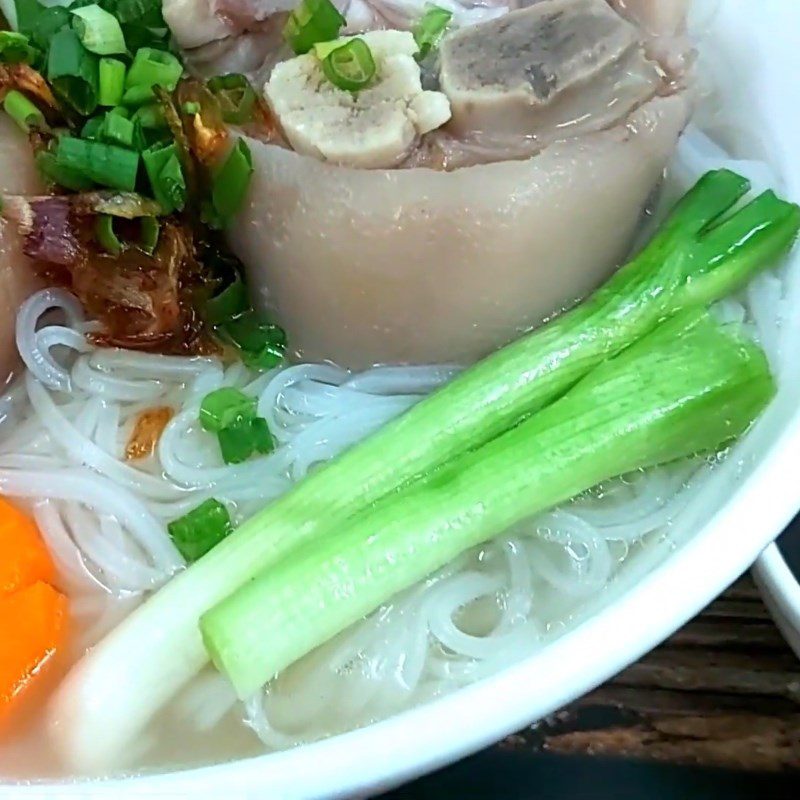
2. Pork Leg Noodle Soup with Spicy Fat
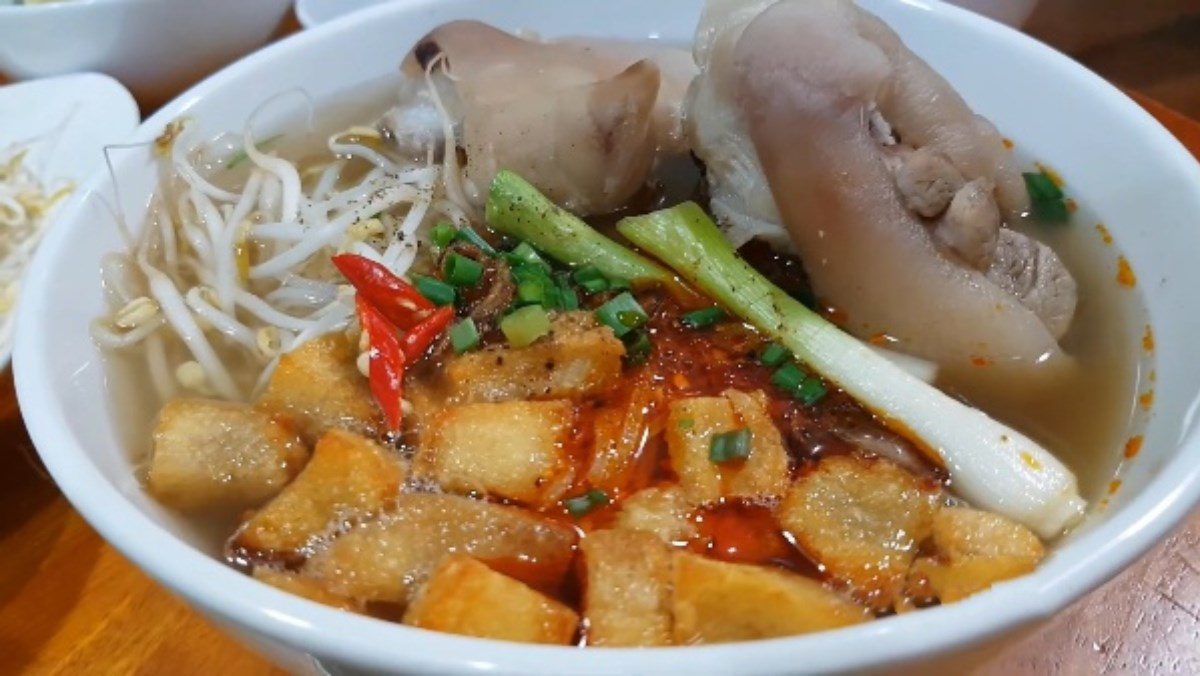
-
Preparation
30 minutes
-
Cooking
1 hour 10 minutes
-
Difficulty
Easy
Ingredients for Pork Leg Noodle Soup with Spicy Fat Serves 4
Dried Noodles 300 gr Pork Leg 1.2 kg Pork Fat 100 gr Dried Shrimp 20 gr Dried Squid 2 pieces White Radish 250 gr (1 piece) Carrot 250 gr (1 piece) Kohlrabi 1 piece Onion 1 piece Shallot 8 pieces Ginger 100 gr (1 piece) Garlic 1 clove Green Onion 5 stalks Horn Chili 1/2 piece Cilantro 5 stalks Star Anise 3 pieces Lemon Juice 2 tablespoons Spicy Chili Paste 1 teaspoon Fish Sauce 3 tablespoons Peppercorn 1/2 tablespoon Rock Sugar 2 tablespoons Common Seasoning a little (Seasoning/ salt/ monosodium glutamate)
How to choose fresh and delicious ingredients
How to choose fresh pork fat
- Fresh and delicious pork fat is fat located in the shoulder or neck area, as the fat here when processed will have a more fragrant aroma and richer taste compared to other parts.
- You should buy pieces of pork fat that are bright white, look evenly colored, and when pressed, feel firm with good elasticity, soft but not mushy.
- Additionally, avoid buying pork fat that emits an unusual fishy smell, especially if it is slimy or has turned a cloudy yellow color, as this means the fat has been kept for too long and is not good for health.
Where to buy chili paste
- The most common place to buy chili paste is at supermarkets, markets, grocery stores, or the TasteVN supermarket near your home. However, don’t forget to check the origin and expiration date of the product.
- Besides, you can also find chili paste on e-commerce websites or go directly to the website bachhoaxanh.com to place an order.
- Moreover, if you have time, you can make chili paste at home with the extremely easy recipe below from TasteVN without having to worry about health issues anymore!
How to choose fresh and delicious kohlrabi
- Fresh and delicious kohlrabi are those with a moderate size, light green skin, feel heavy in hand, and when observing the stem, it should be fresh and tightly attached to the body, not separated.
- In addition, you should buy kohlrabi that are intact, not bruised, deformed, or of abnormal shape.
- Limit buying kohlrabi when it feels too soft to the touch, the surface has many tiny spots due to pest damage, lacks stems or leaves, or has yellowed leaves as these are signs that the kohlrabi has been stored too long and should not be eaten.
How to choose delicious dried shrimp and dried squid
- Delicious dried shrimp and dried squid will have natural colors, bright colors, not too dark, and there should not be any unusual tiny spots on the surface or any abnormal color changes.
- When touched, they should feel firm, not too hard or too soft, especially when smelling, there should be no fishy odor emanating as it could be dried shrimp or dried squid soaked in chemicals for longer preservation.
- Additionally, you should avoid buying dried shrimp and dried squid that are too dark in color as these may be dyed, which is not good for health.
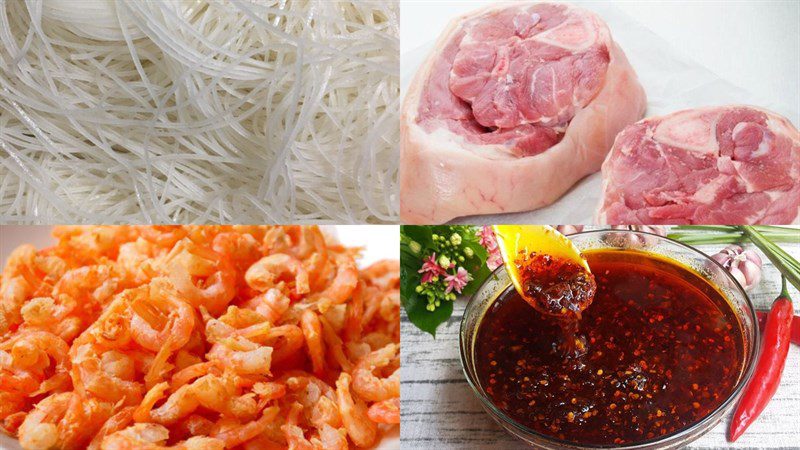
How to prepare Pork knuckle noodle soup with crispy fat and satay
-
Prepare the pork knuckle
First, with 1.2kg of pork knuckle bought, wash it with diluted salt water for 3 – 5 minutes, then rinse several times with clean water and let it drain.
At the same time, place a pot on the stove with 500ml of water on high heat. Once the water is gently boiling, add 1/2 tablespoon of salt, the entire prepared pork knuckle, 1 bulb of shallot, and 100g of smashed ginger, and blanch for about 3 – 5 minutes.
When you see the pork knuckle slightly firming up, turn off the heat, remove the pork knuckle to a bowl of cold water, let it cool for 3 minutes, then rinse again with clean water and let it drain.

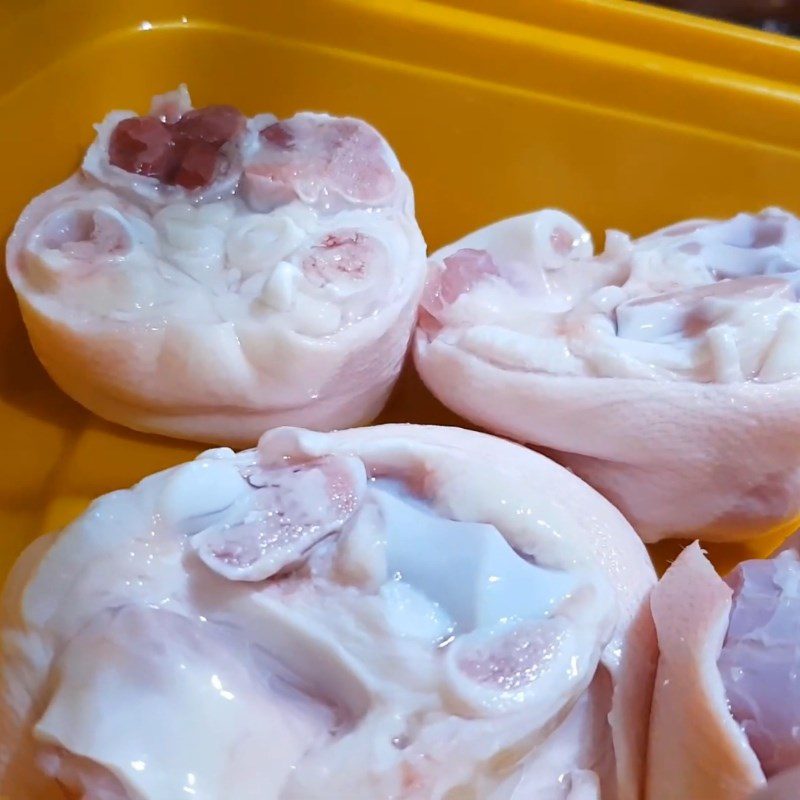
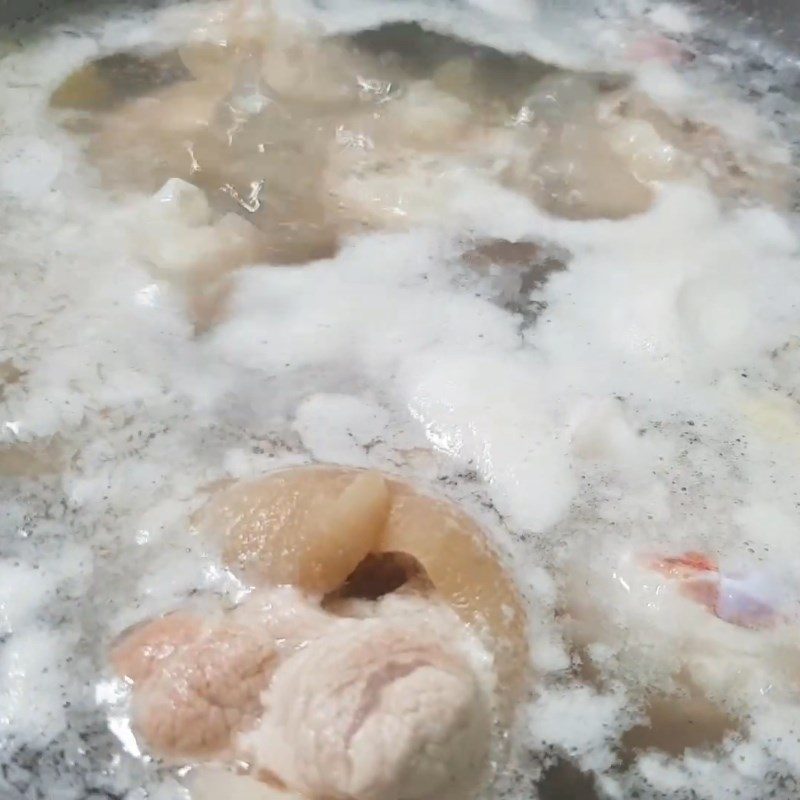

-
Prepare other ingredients
Pork fat bought should be rubbed with a little salt on the surface for 3 – 5 minutes, then washed with clean water, drained, and cut into bite-sized cubes.
For carrots, kohlrabi, and white radish, use a peeler to peel the skin, then rinse directly under running water to clean, drain, and cut into rounds.
Green onions and coriander should have their roots removed, washed clean, drained, and cut into sections. As for shallots and garlic, peel them, then slice the garlic.
Onions should also be peeled, then use a knife to cut them in half. Finally, for chili peppers, cut them diagonally into slices.
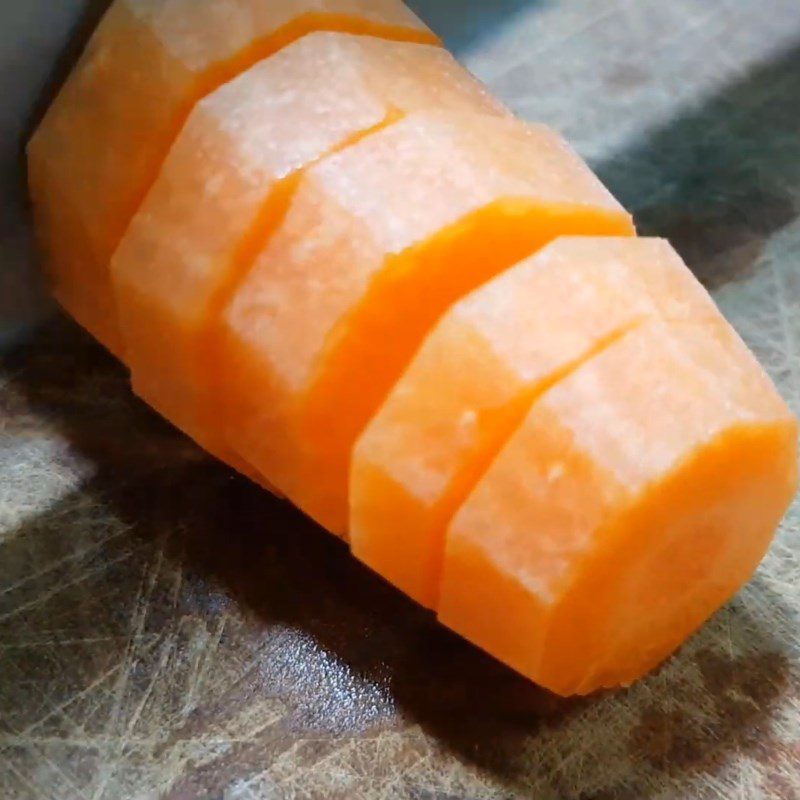
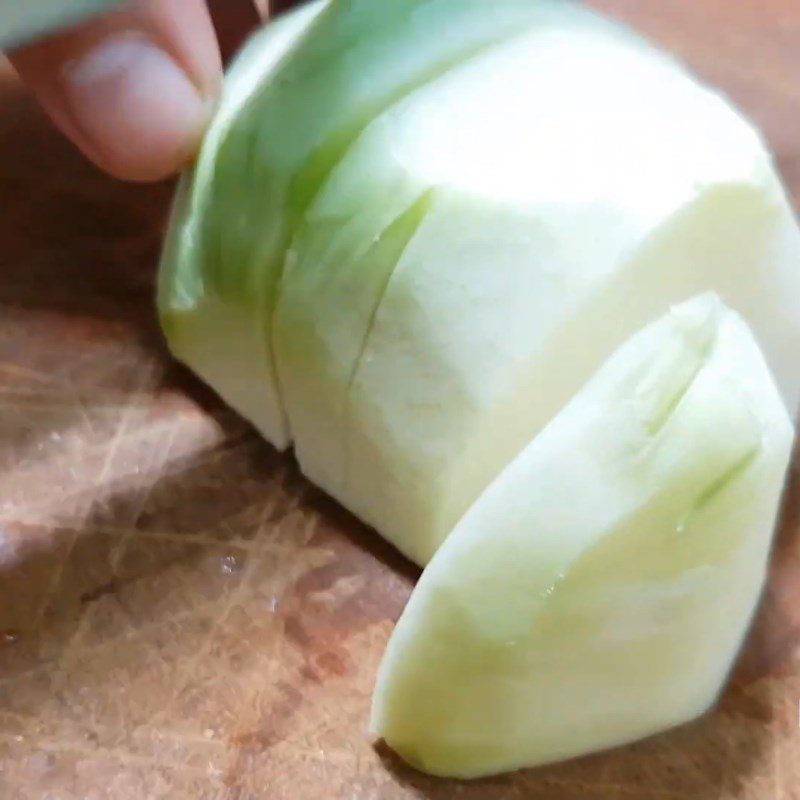
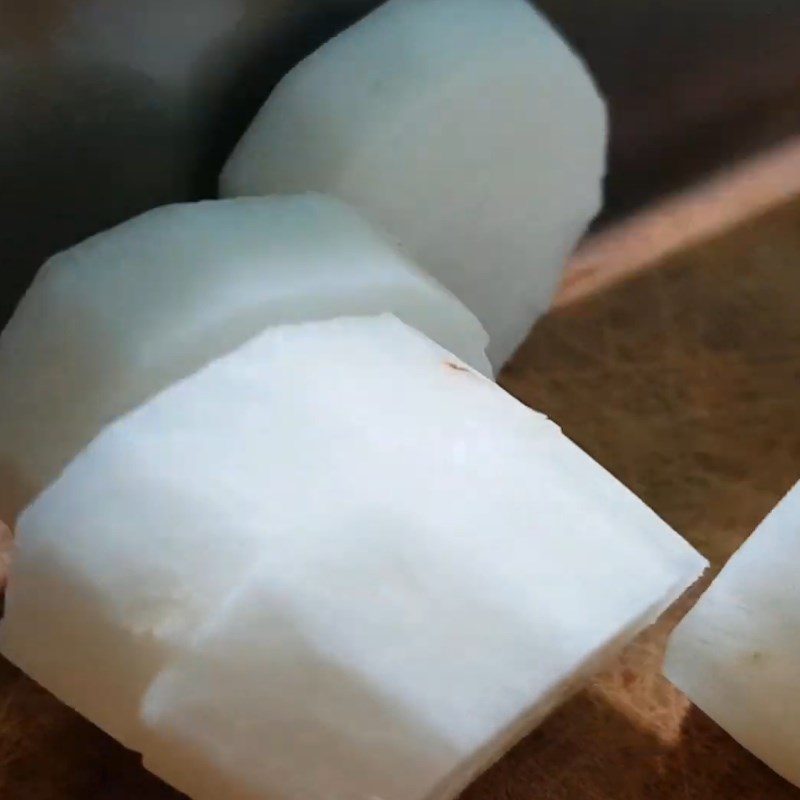
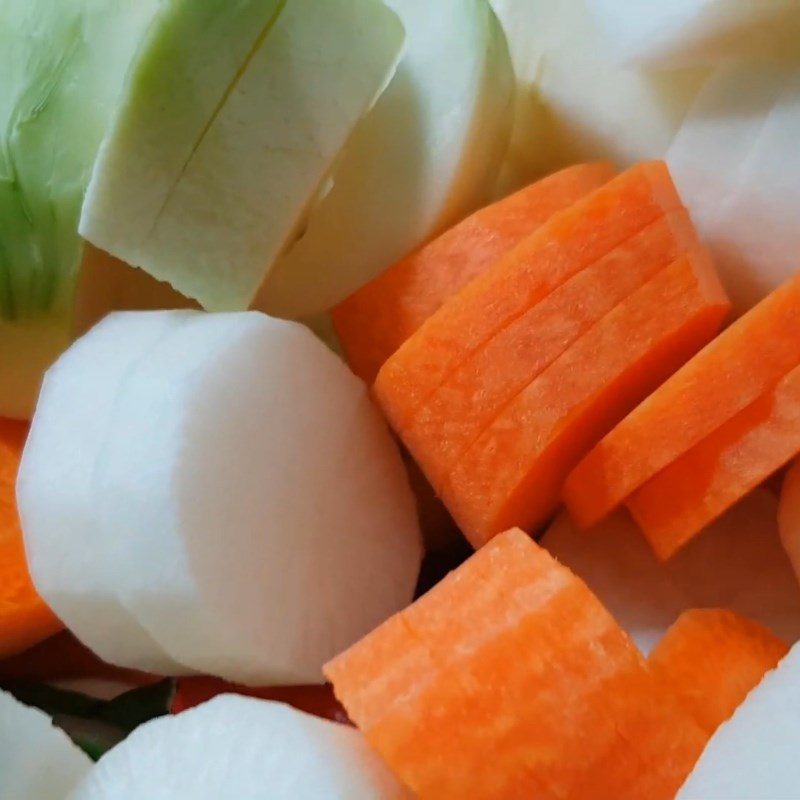
-
Grilling the ingredients
Next, place a pan on the stove with 2 dried squids and 20g of dried shrimp and sauté over low heat for about 3 minutes. Then, add star anise and 1/2 tablespoon of whole pepper, and continue to sauté for another 3 minutes.
When the ingredients are fragrant, turn off the heat and transfer them to a plate.
After that, using the same pan, place it back on the stove with 1 onion and the remaining shallots, and sauté over low heat for about 3 – 5 minutes. When the ingredients are golden and fragrant, turn off the heat and transfer them to the plate.

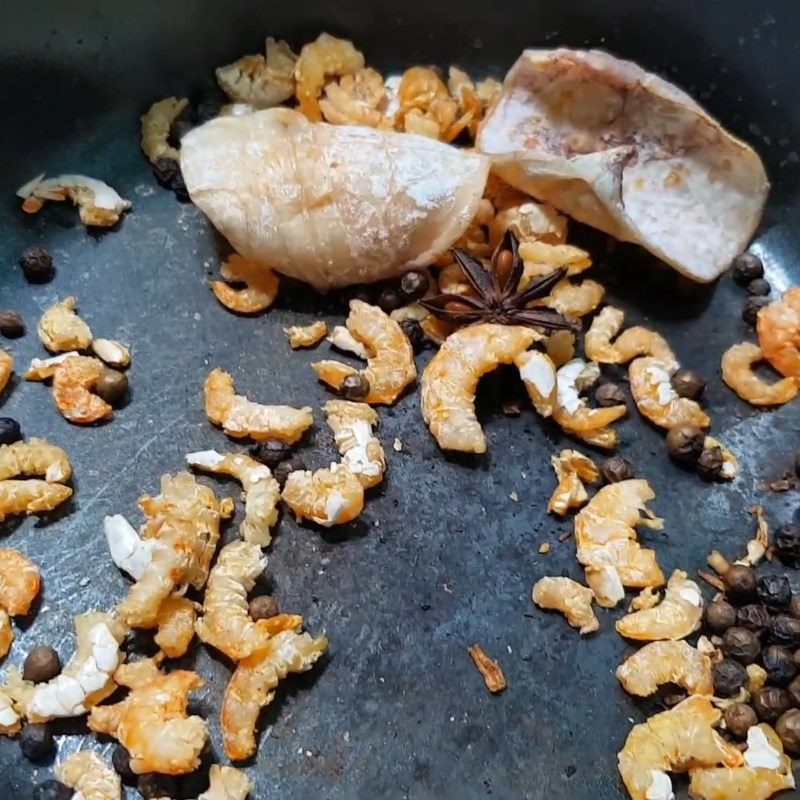
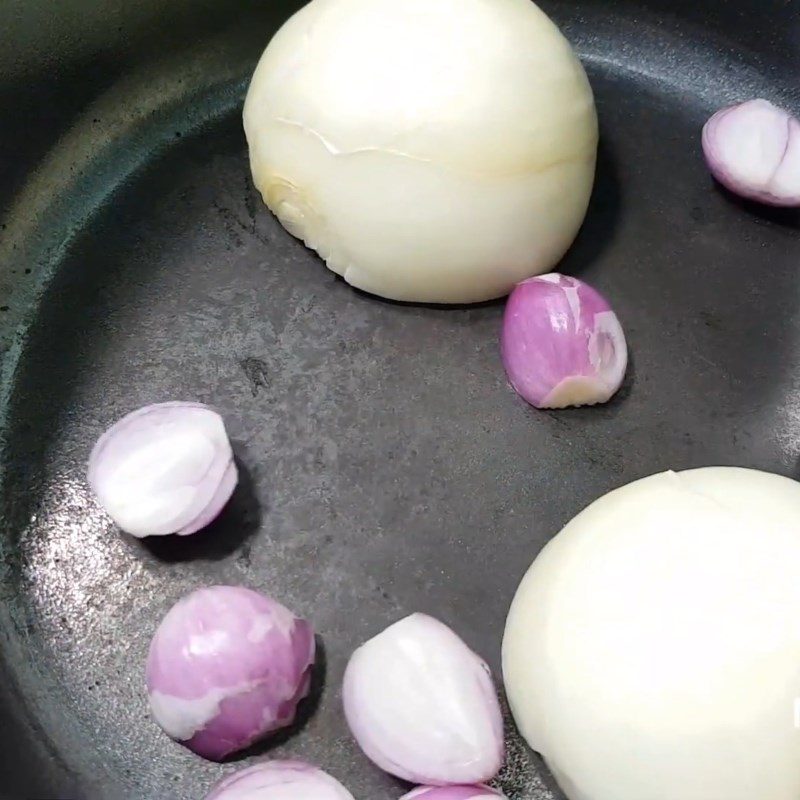
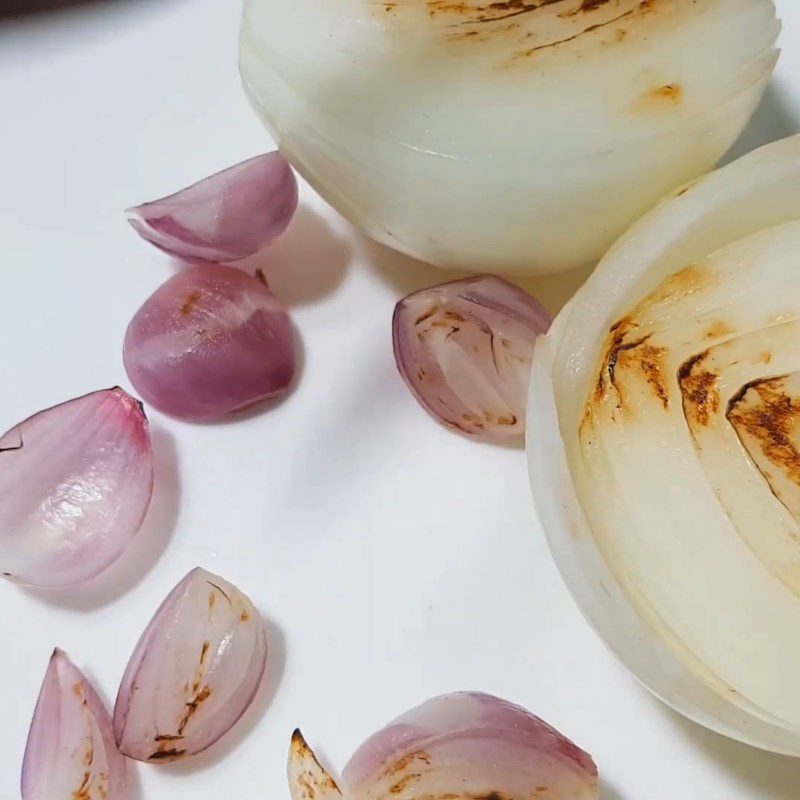
-
Cooking the broth
After preparing the ingredients, place another pot on the stove with 3 liters of water over high heat.
When the water starts to boil, reduce the heat to medium, and add all the pork hocks, kohlrabi, white radish, carrot, 1 onion, 7 shallots, 2 dried squids, and the amount of dried shrimp, star anise, cinnamon, and whole pepper into it, and cook for about 10 – 15 minutes.
When the water is boiling, add 5 stalks of green onions, 5 stalks of cilantro roots, 1/2 tablespoon of salt, 2 tablespoons of seasoning powder, 2 tablespoons of rock sugar, and 1/2 teaspoon of monosodium glutamate, using a ladle to stir well and continue cooking for another 40 – 45 minutes.
When the pork hocks are tender, turn off the heat, remove the pork hocks and other ingredients into a bowl. Then, use a strainer to filter the broth, and then continue to put it back on the stove over medium heat.
When the broth comes to a boil again, adjust the seasoning to taste.

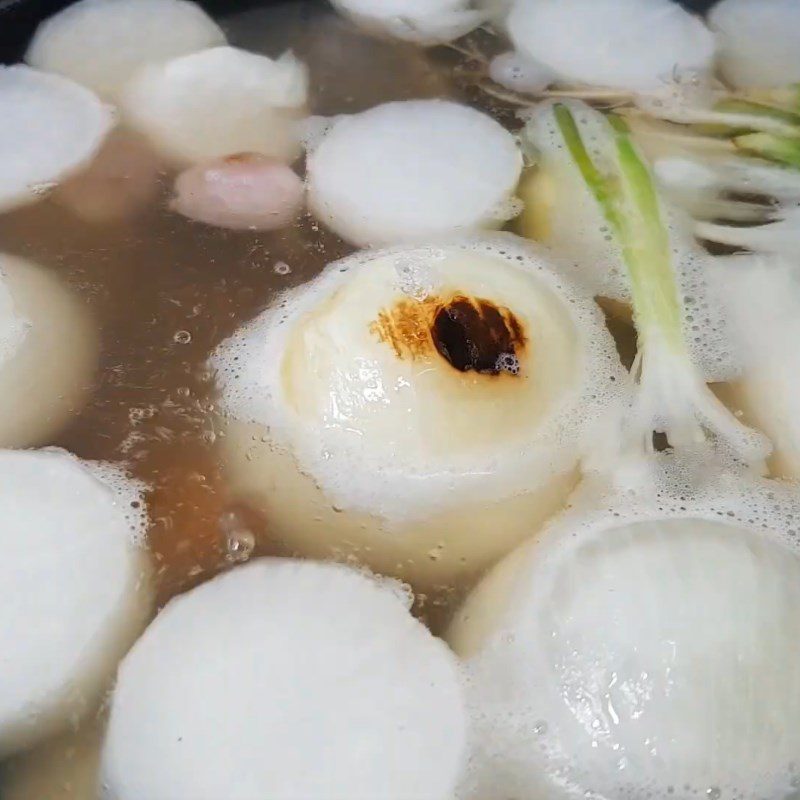
-
Frying Pork Cracklings
While cooking the broth, you place another pan on the stove with 100g of pork fat and 1/3 teaspoon of salt, and proceed to fry the pork cracklings on low heat for about 10 – 15 minutes.
When the cracklings are golden and crispy, turn off the heat and transfer them to a bowl.
How to Fry Crispy Pork Cracklings Without Oil Splatter
- To avoid oil splatters that can cause burns, make sure the pork fat is really dry before frying.
- If you want the cracklings not to break, when adding them to the pan, do not stir immediately but wait for 2 – 3 minutes before stirring!
- Additionally, for the cracklings to be crispy and tasty, when you see them starting to shrink, do not take them out immediately but fry for an additional 3 – 5 minutes.
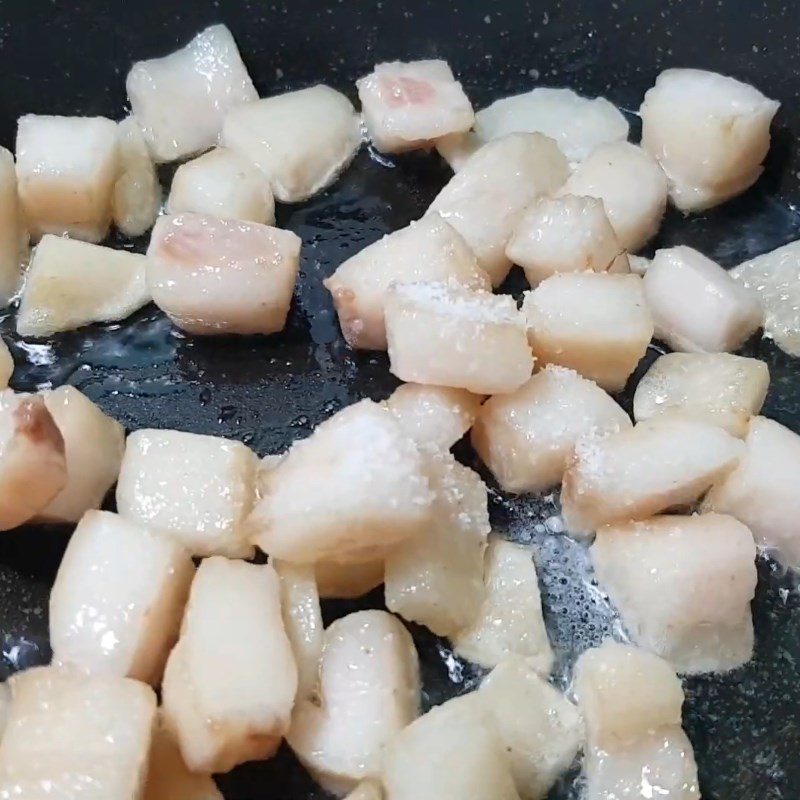
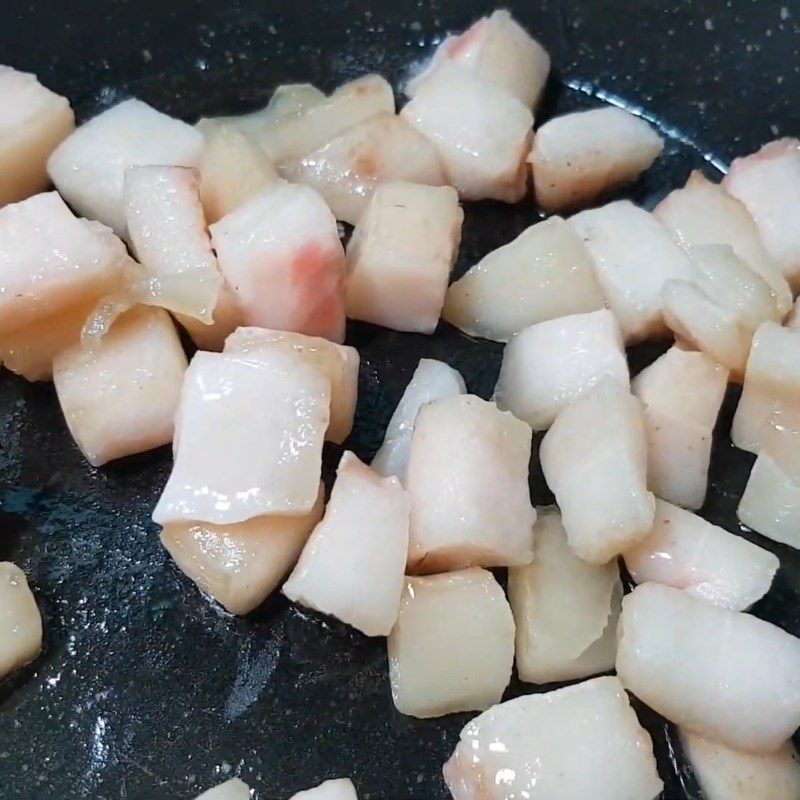

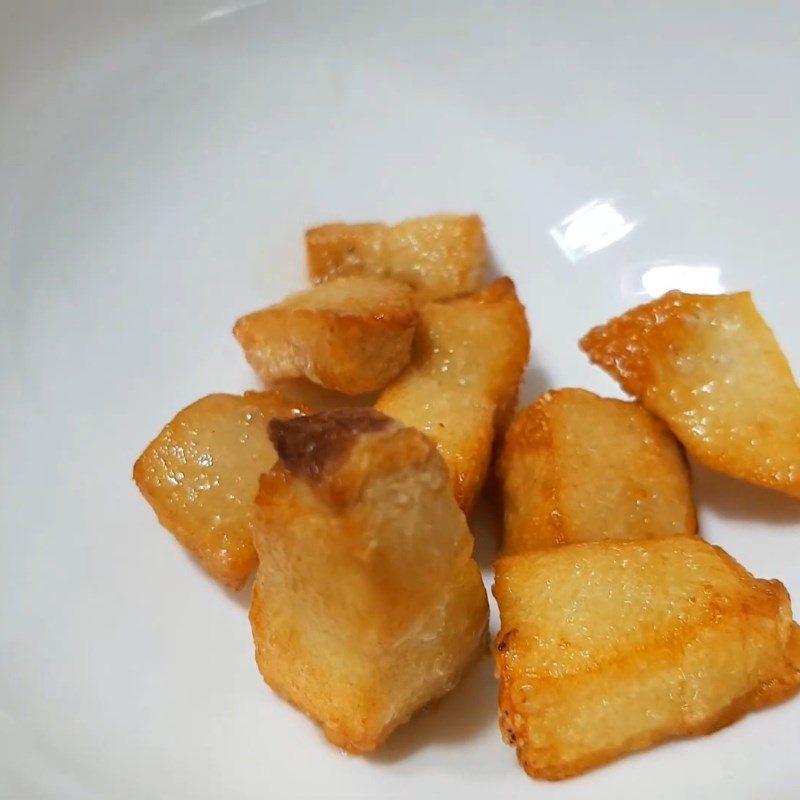
-
Blanching Noodles
Next, place another pot on the stove with 500ml of water over high heat. When the water boils, add all the noodle strands and blanch for about 3 – 5 minutes.
Once the noodles are soft, turn off the heat and remove the noodles to a bowl.
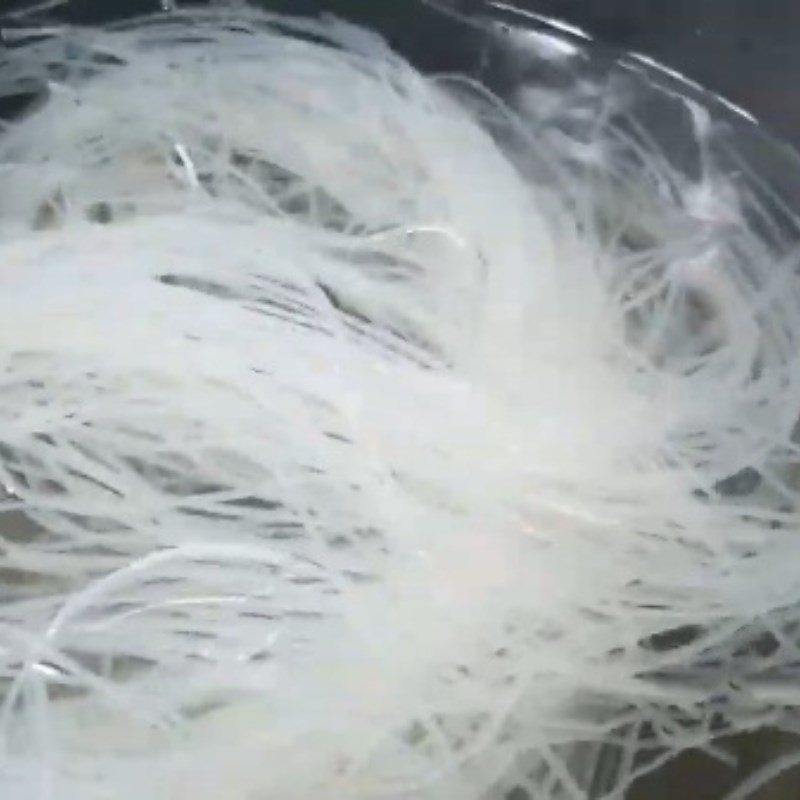
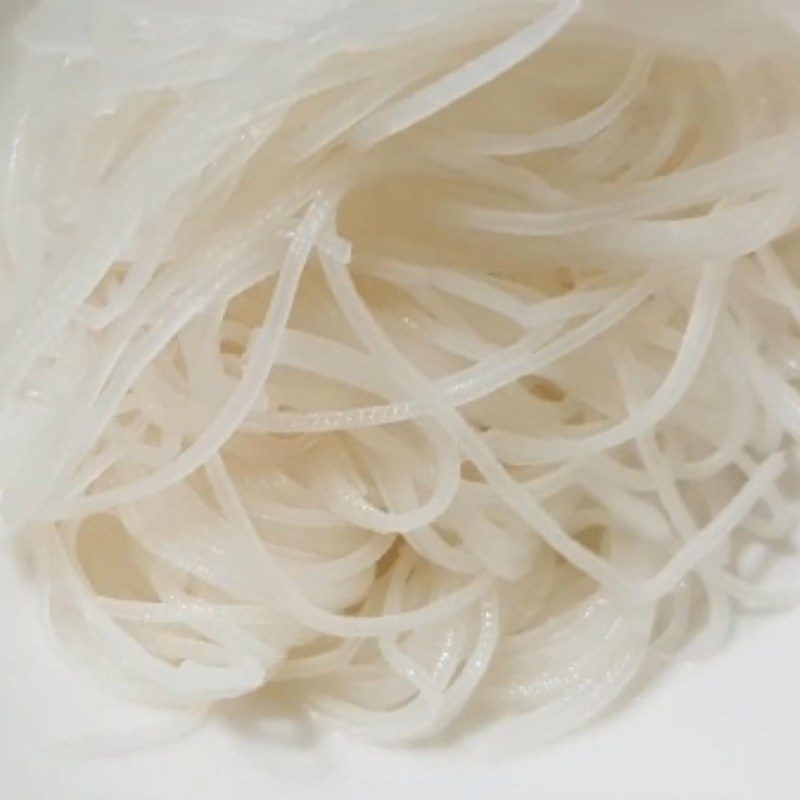
-
Prepare the dipping sauce and finish
Then, take a bowl and add 1 teaspoon of satay chili, 1/2 sliced chili, 1 sliced garlic clove, 3 tablespoons of fish sauce, 1 tablespoon of sugar, and 2 tablespoons of lime juice, and use a spoon to mix well until the mixture is combined.
Finally, prepare a bowl and successively add a little noodles, pork leg, and the ingredients you just cooked along with some chopped green onions and cilantro, then enjoy right away!
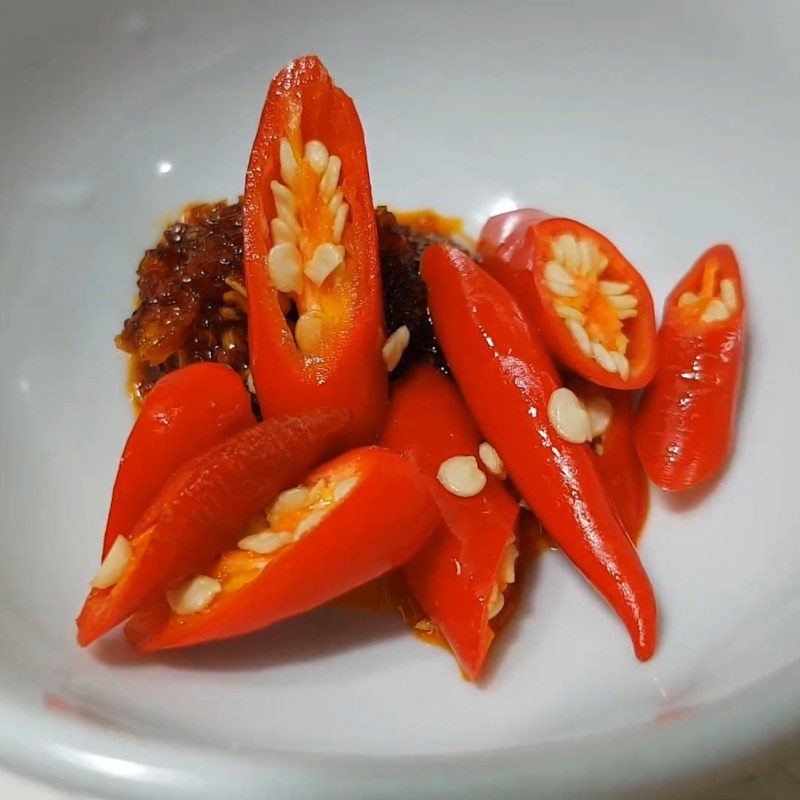

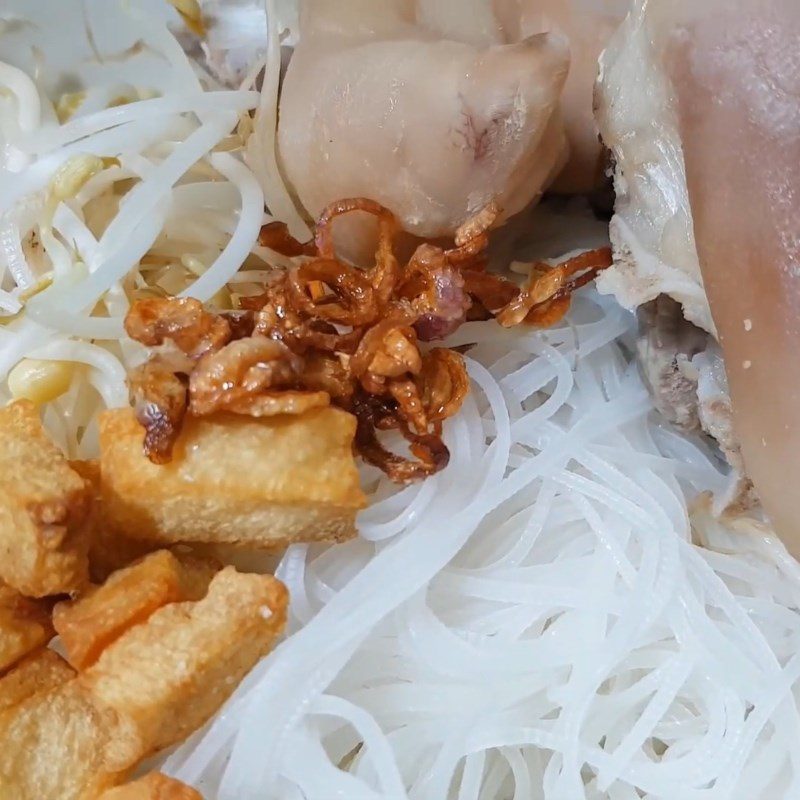
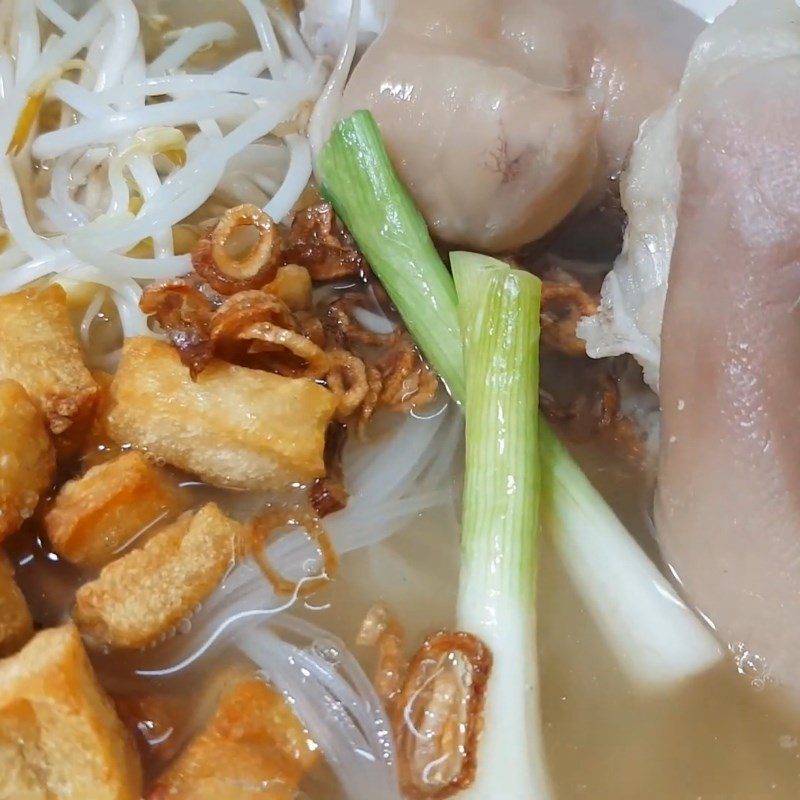
-
Final Product
Pork trotter dry noodle with crispy pork fat and satay is not too difficult to make, but the delicious flavor it brings is truly intoxicating!
The hot broth, sweet and rich, is very hard to resist, especially the chewy noodle strands combined with the tender pork trotter and various vegetables help to reduce the greasiness, with a hint of spice on the tip of the tongue, it is indeed wonderful!
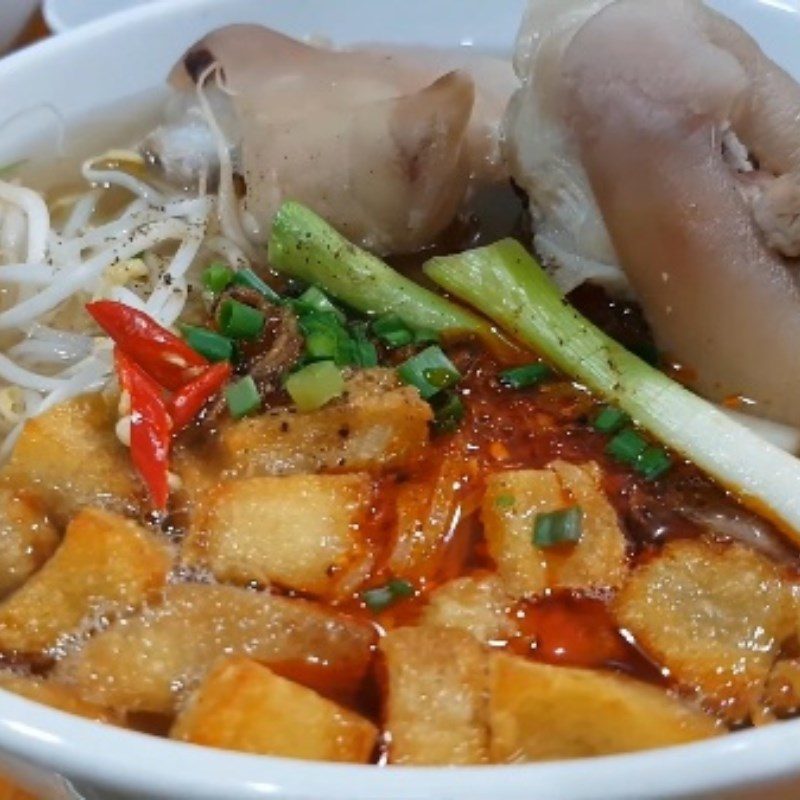
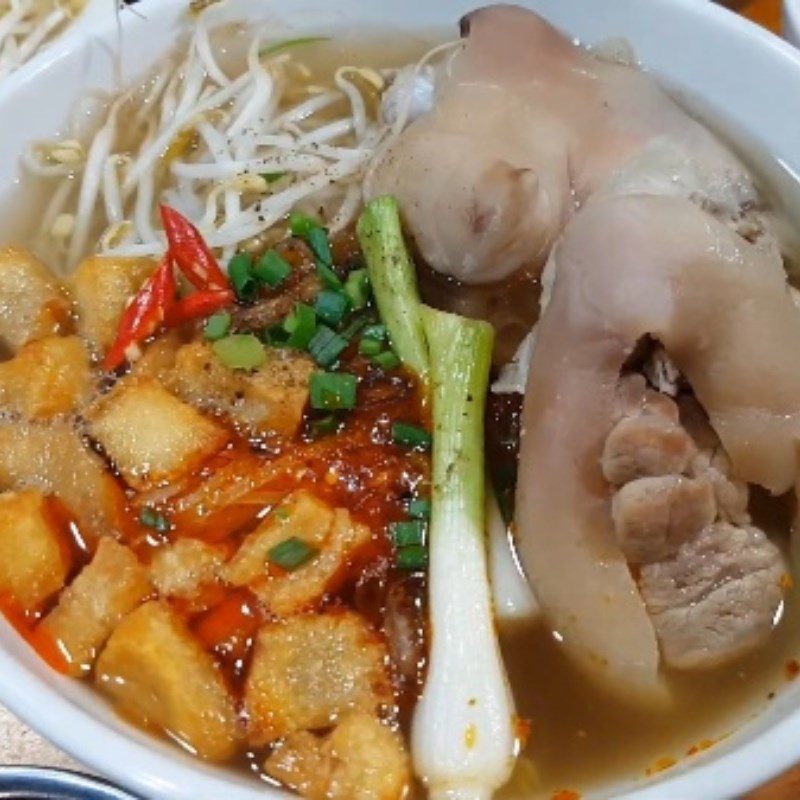
3. Pork trotter dry noodle with quail eggs
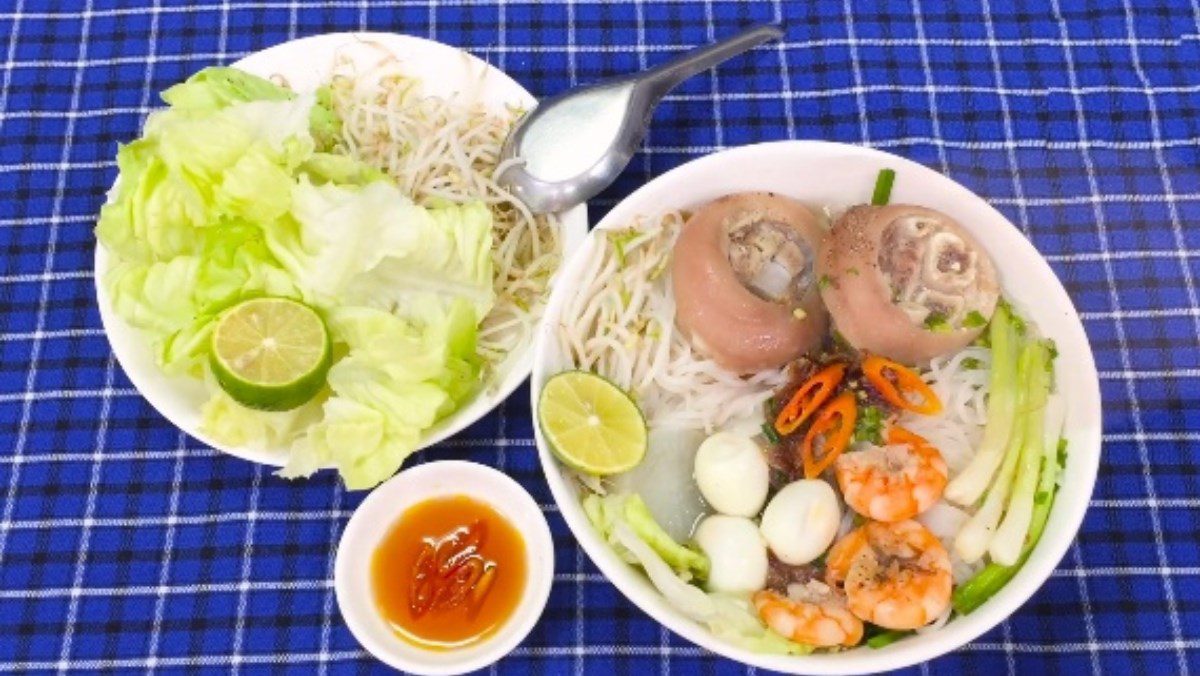
-
Preparation
30 minutes
-
Cooking
1 hour
-
Difficulty
Easy
Ingredients for Pork trotter dry noodle with quail eggs Serves 3 people
Dry noodles 200 gr Pork trotter 900 gr Shrimp 400 gr Quail eggs 15 eggs Onion 1/2 bulb Shallots 7 bulbs Garlic 2 cloves Cooking oil 3 tablespoons Common seasoning a little (Seasoning powder/ salt/ sugar/ monosodium glutamate/ ground pepper)
How to choose fresh ingredients
How to choose fresh shrimp
- Fresh shrimp will have a translucent shell; conversely, if they appear dark or have uneven colors, then the shrimp are dead, and the flesh will be mushy and not tasty.
- When picked up, fresh shrimp should feel firm and strong, able to bounce away, while the shell joints are flexible, and the head and body of the shrimp are tightly connected, not separated, indicating they are fresh shrimp.
- In addition, observe the tail; if it is tightly folded together, then it is fresh shrimp; on the contrary, if it is spread out, then it has likely been injected with chemicals or water to appear plumper.
- Avoid buying shrimp that feel slimy, have a rounded, bent body, with legs that do not cling tightly to the body, and if pressing on the shell feels soft and mushy.
How to choose fresh quail eggs
- Fresh quail eggs have a beautiful, sturdy outer shell with clear patterns, and especially no rough shapes or unusual blemishes on the surface.
- Moreover, quail eggs that have a thin powdery coating on the shell and are mostly uniform in size are usually signs of fresh quail eggs.
- Additionally, if they feel too light when held, and shaking them produces the sound of liquid sloshing inside, then they should definitely not be purchased.
- Avoid buying quail eggs with shells that are crushed, cracked excessively, or soft and mushy, as these are signs that the eggs have spoiled due to prolonged storage.
-800x450.jpg)
How to prepare Pork leg noodle with quail eggs
-
Prepare the ingredients
First, take the pork leg you bought and rub a little salt over the surface of the meat for 3 – 5 minutes, then rinse it a few times with clean water and let it drain.
At the same time, place a pot on the stove with 500ml of water on high heat. When the water boils, add the entire pork leg that has just been prepared, and blanch it for about 3 – 5 minutes, then remove it to a bowl.
For the shrimp, use your hands to remove the heads, peel off the shells, then use a scissors or a knife to insert into the back of the shrimp to remove the intestinal thread. Next, rinse them briefly with water to clean and let them drain.
For the white radish, cut off the top, use a peeler to peel the skin, wash it clean, let it drain, and then cut into bite-sized pieces.
Finally, peel the garlic and shallots. Then, chop 2 shallots and 2 cloves of garlic finely.
How to quickly remove the shrimp’s intestinal thread
- Method 1: First, turn the shrimp upside down, then gently bend the head from bottom to top while gently squeezing to push the dirty part of the shrimp out. Next, hold onto that dirty part and the thread will also be removed.
- Method 2: Another common method is to turn the shrimp over, then peel both sides of the shrimp head while holding tightly at the joint between the body and head, and gently pull it out with your hands; the intestinal thread will come out as well.

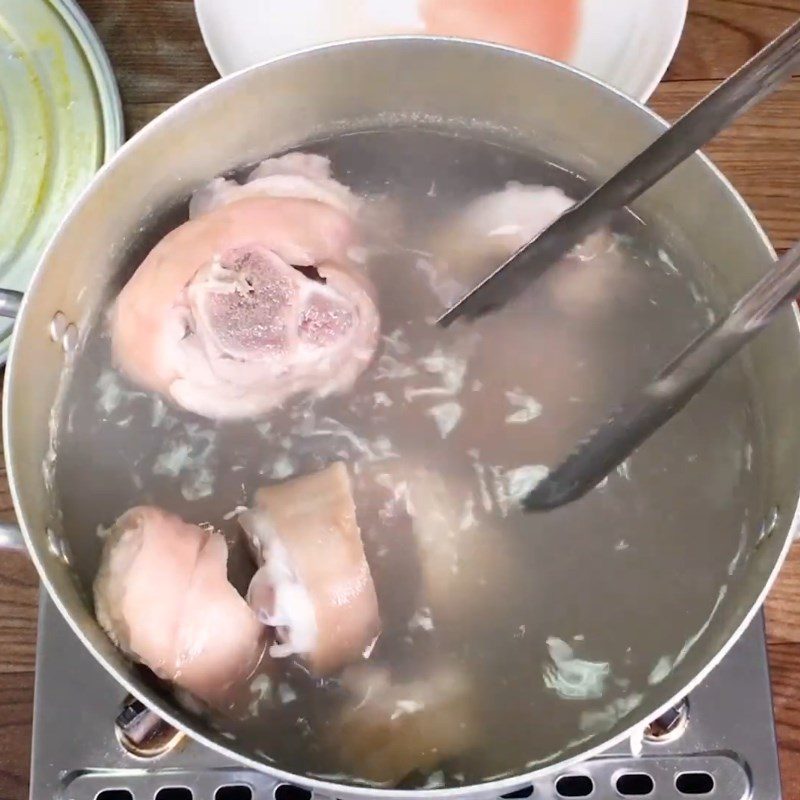

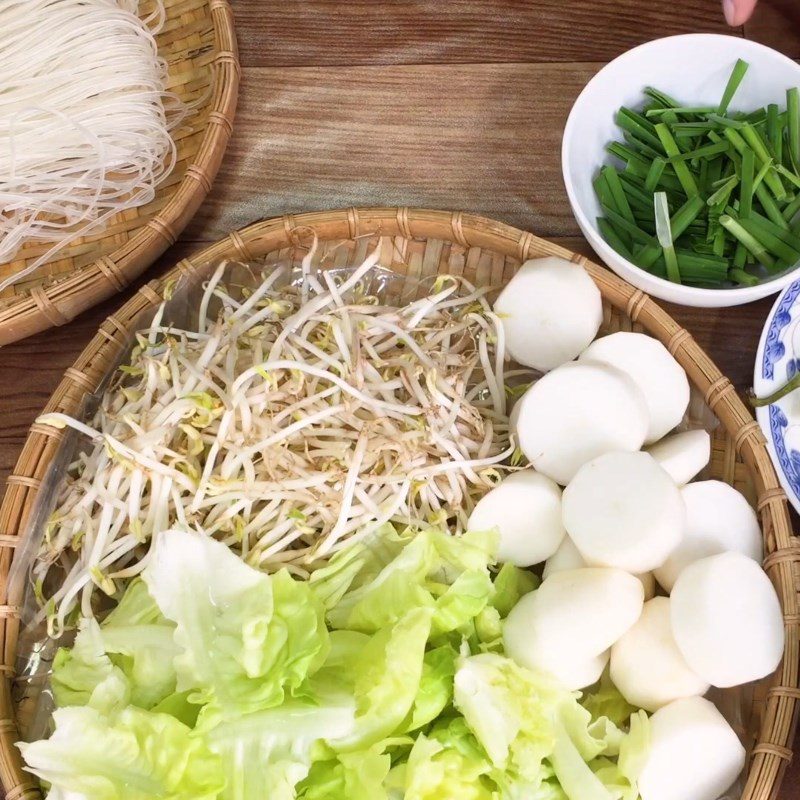
-
Marinate and stir-fry the shrimp
Next, take a plate and add 400g of cleaned shrimp, half of the minced shallots, half of the minced garlic, 1 teaspoon of seasoning, 1/2 teaspoon of ground pepper, and 1 teaspoon of sugar. Use a spoon to mix thoroughly and let the shrimp absorb the seasoning for 10 minutes.
Then, heat a pan on the stove with 3 tablespoons of cooking oil and the remaining minced shallots and garlic, sautéing until fragrant over medium heat.
Next, add all the marinated shrimp, using chopsticks to stir-fry for about 5 – 7 minutes, until the shrimp are cooked, then turn off the heat and transfer to a plate.
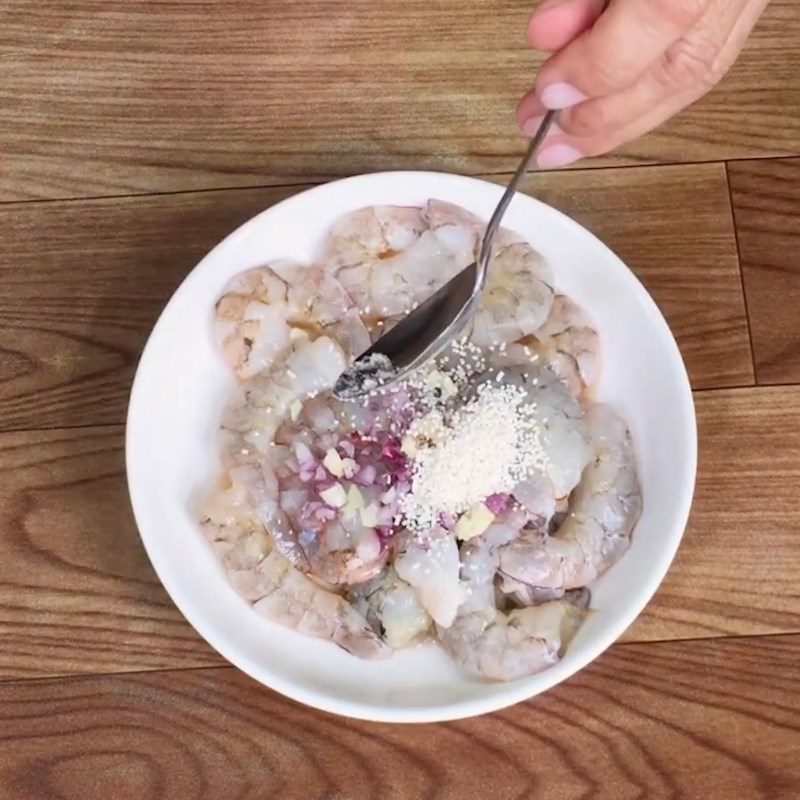
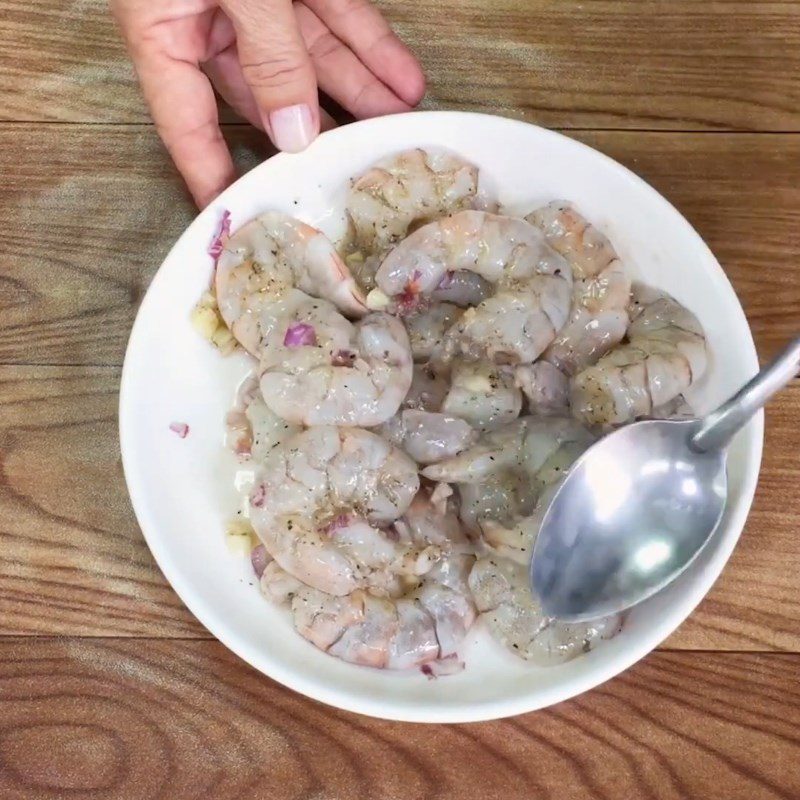


-
Boil quail eggs and egg noodles
Next, you put a new pot on the stove with 500ml of water over high heat. When the water boils, reduce to medium heat and add 15 quail eggs to boil for about 7 – 10 minutes.
When the quail eggs float to the surface of the water, they are cooked, then turn off the heat, take them out into a bowl, let them cool, and then peel.
After that, continue to place another pot on the stove with 500ml of water over high heat. When the water boils, add 200g of dry egg noodles to blanch for about 3 – 5 minutes.
When the egg noodles are soft, turn off the heat and take the noodles out into a bowl.
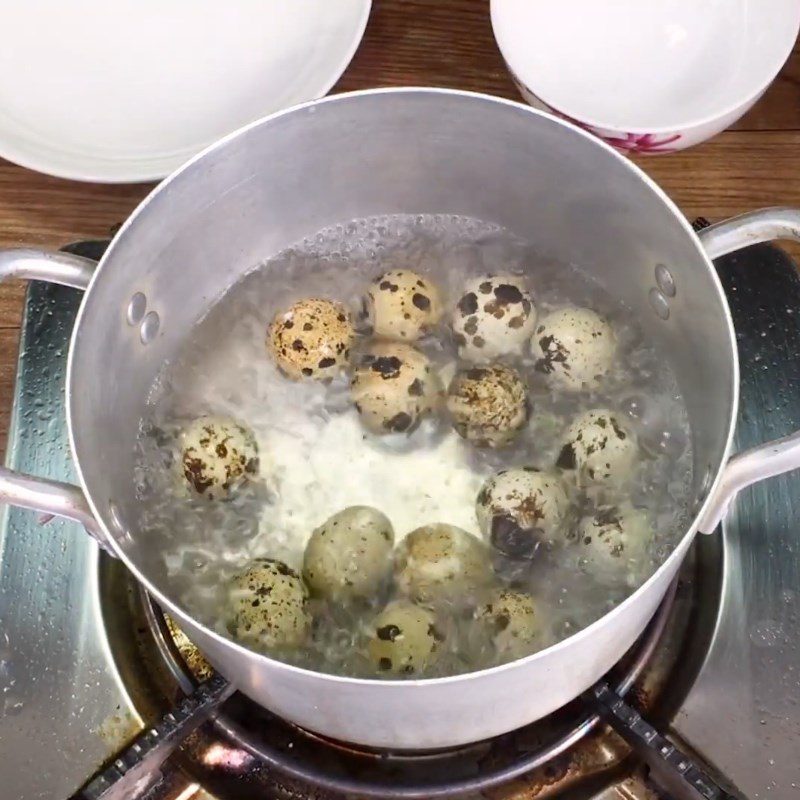
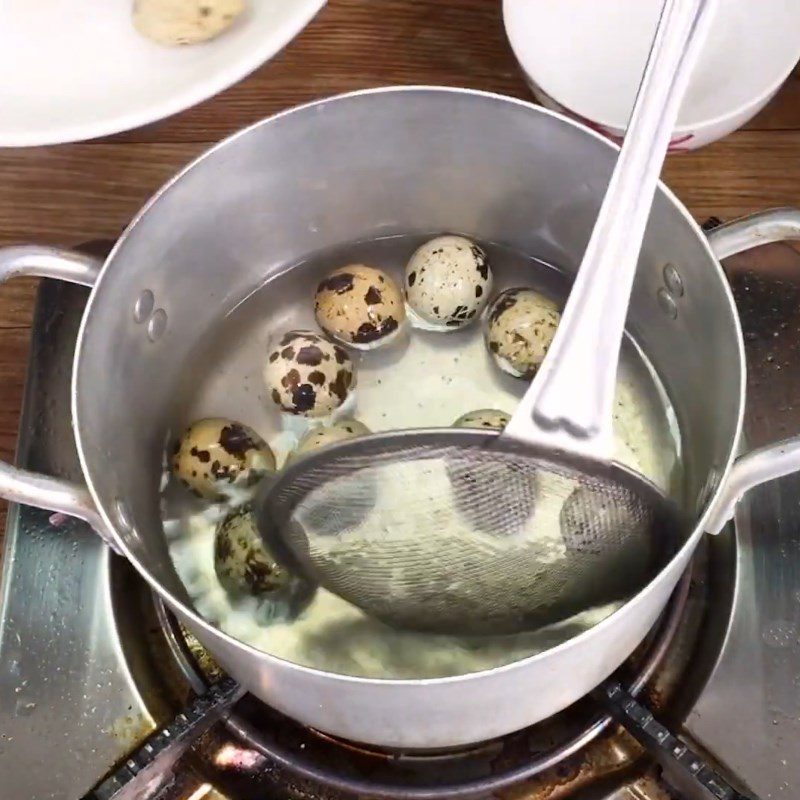
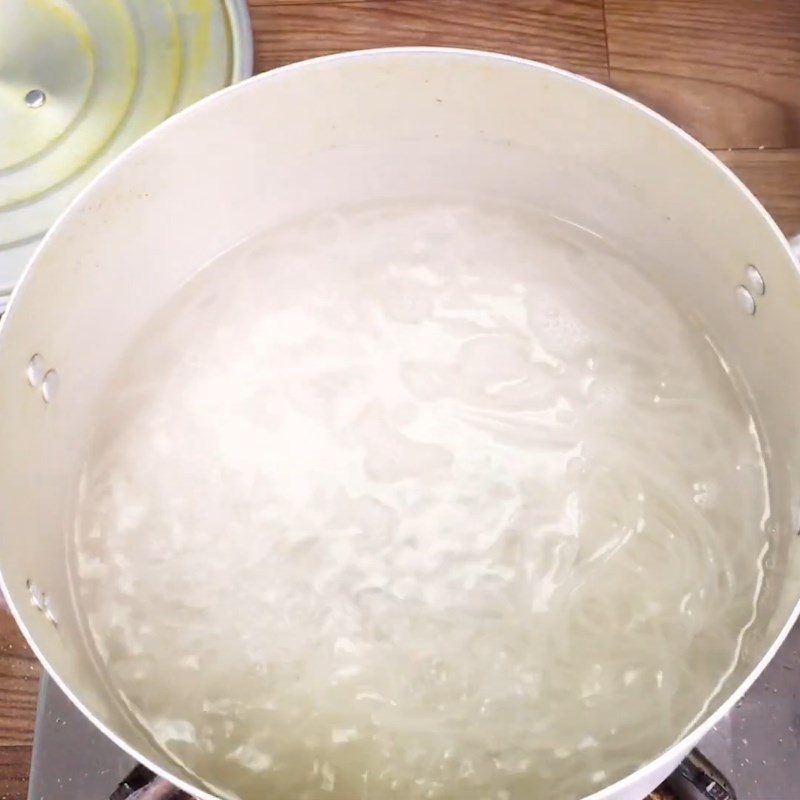
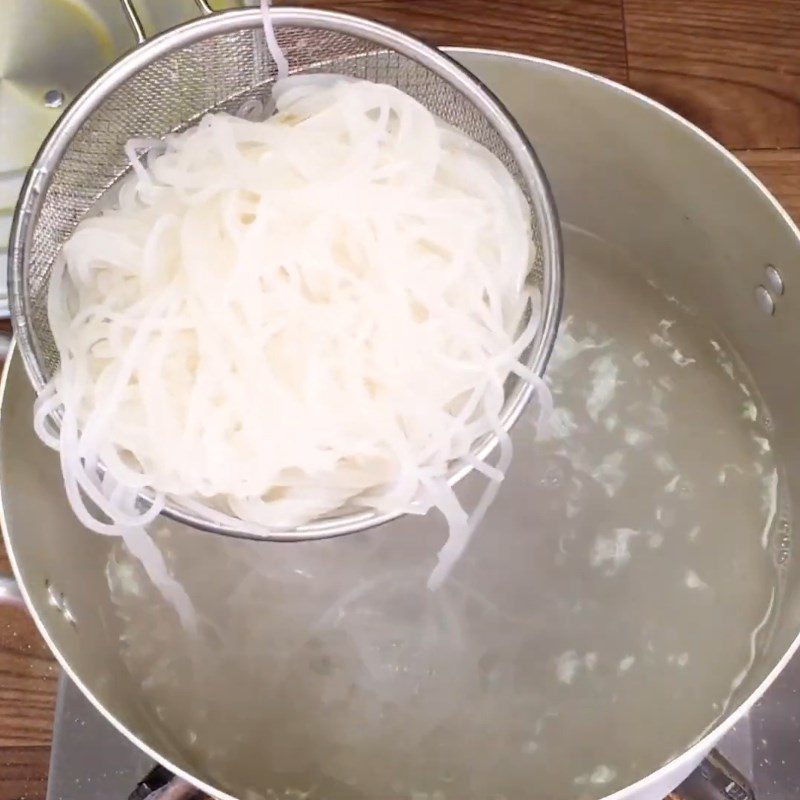
-
Cooking the broth
Once you have prepared the ingredients, place another pot on the stove with 2.5 liters of water, all the previously blanched pork leg, half an onion, and 5 shallots. Proceed to cook over medium heat for about 45 minutes.
After that, add 1 white radish, 1 tablespoon of seasoning, and 1 tablespoon of sugar, then continue to cook for another 15 minutes.
Next, add the sautéed shrimp and 15 quail eggs, cook for another 10 minutes, and then season to taste.

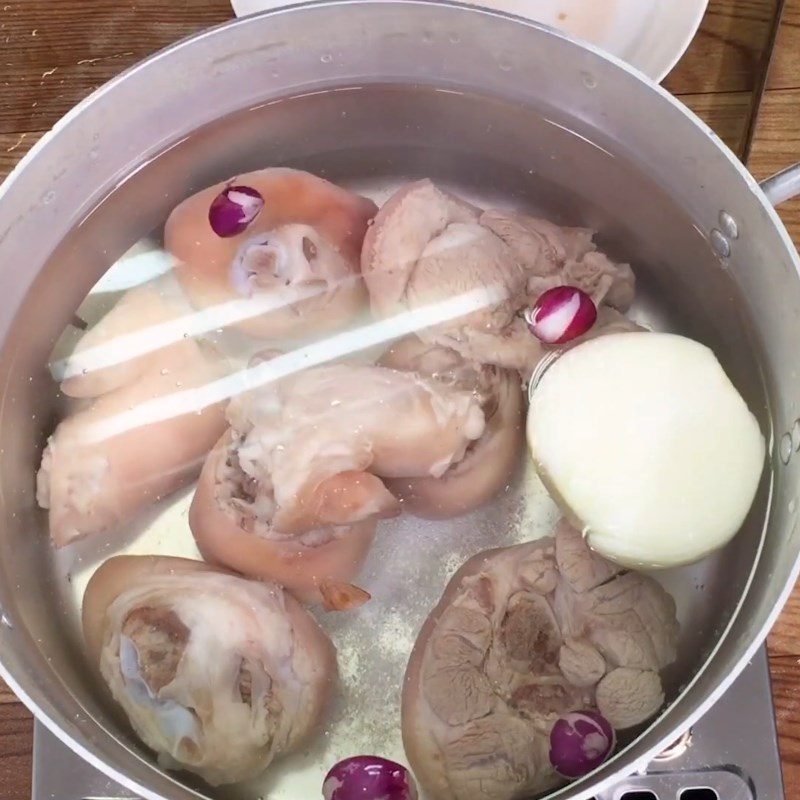
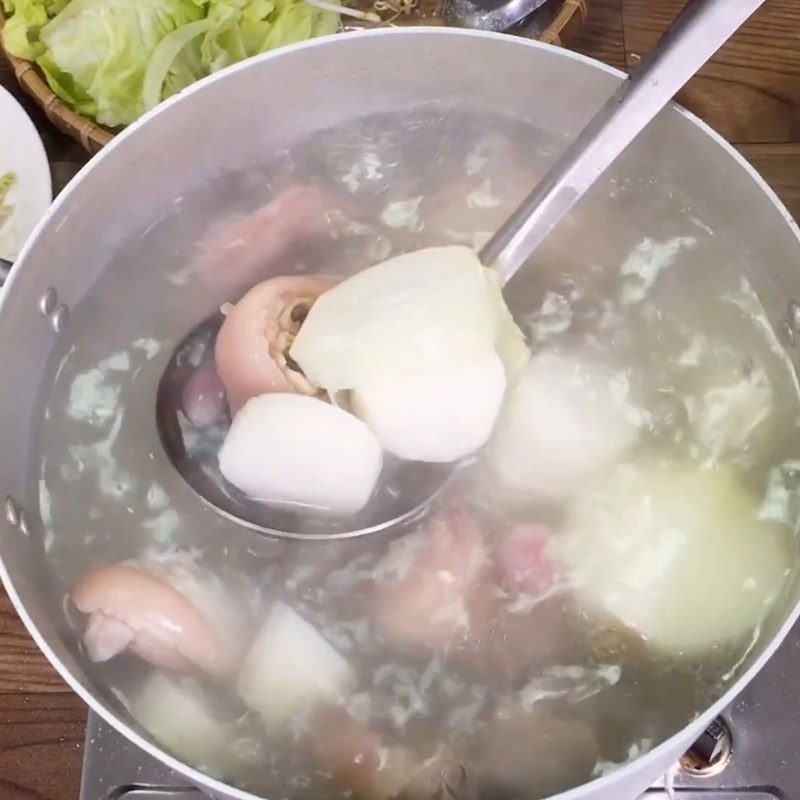
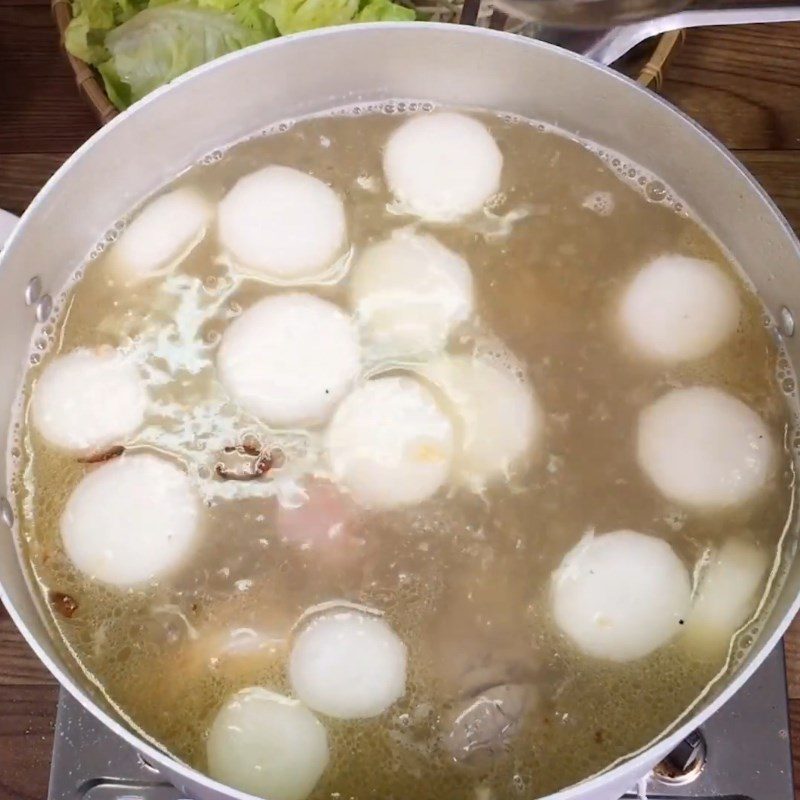
-
Final product
Surely anyone who receives your bowl of Pork Leg Quail Egg Noodles will be amazed by your skills!
The broth is crystal clear, rich, and sweet, very enticing, especially with the tender and chewy pork leg, combined with fresh shrimp and creamy quail eggs—truly delightful!
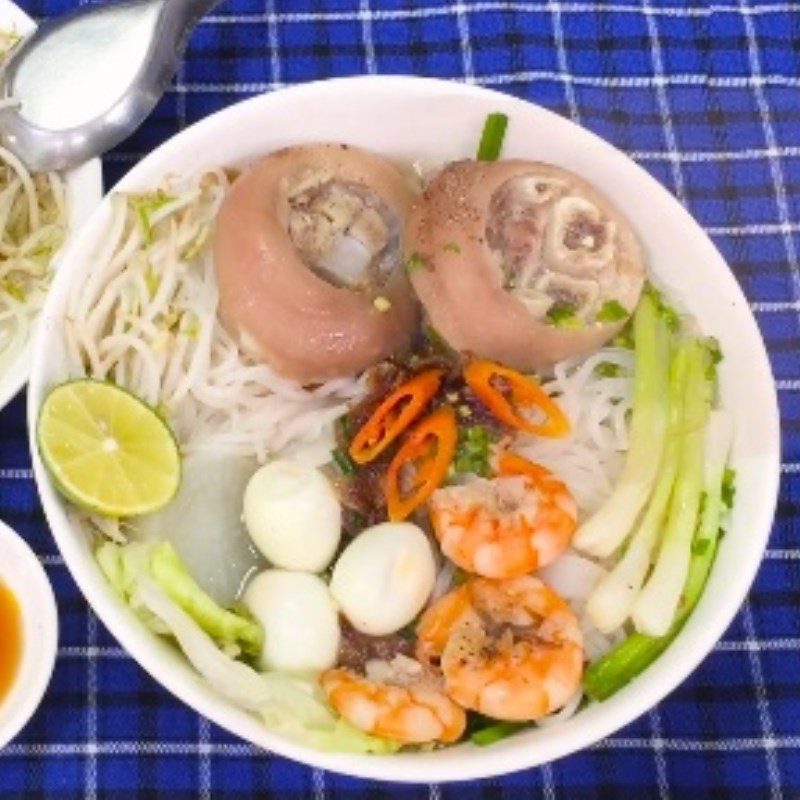
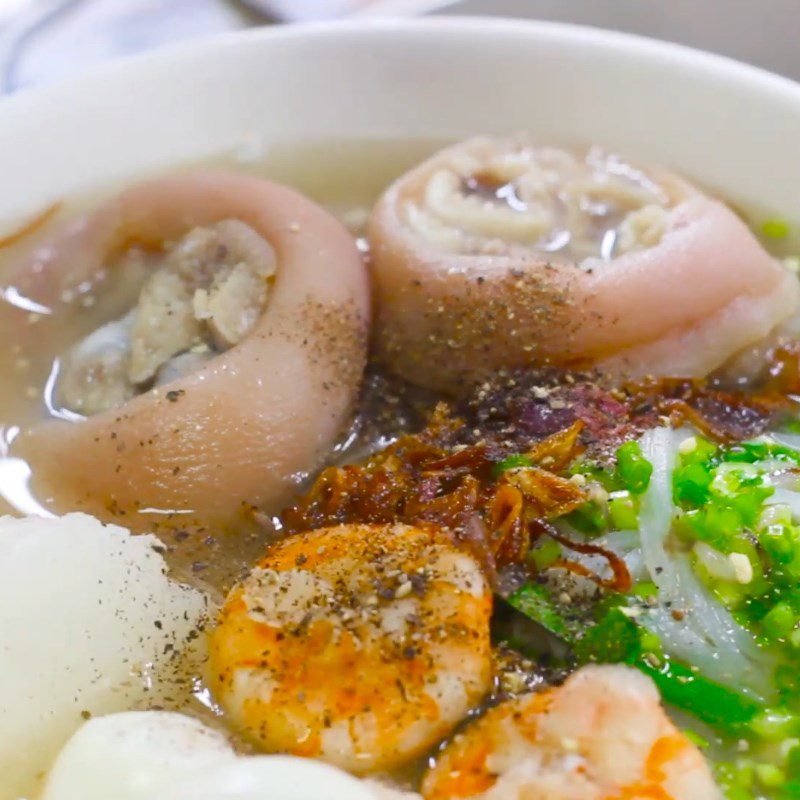
How to choose fresh and delicious pork trotters
- You should choose the hind legs of the pig because the hind legs usually have more meat and higher nutritional value.
- Good trotters usually have good elasticity, the hooves are intact, and there is no hair.
- Types of trotters with unusual colors such as green or purple, with abnormal fluid leaking from inside, indicate that this is a sick pig that has been injected with antibiotics or a pig that has been dead for a long time, absolutely should not be purchased as it will affect the health of consumers.
- It is advisable to buy trotters at reputable supermarkets or food stores to ensure the quality of the trotters.
Effective ways to eliminate the unpleasant smell of trotters
- You can briefly blanch the trotters in boiling water for about 3 – 5 minutes, then rinse them a few times with clean water and the odor will disappear immediately.
- Alternatively, a simpler method is to use a mixture of salt and white wine to rub onto the trotters for 5 minutes, then rinse 1 – 2 times with clean water and you will find the unpleasant smell is gone.
- In addition, another popular method is to soak the trotters in rice water for 15 minutes, which is commonly used by many people.
How to choose and where to buy delicious noodle soup
- Depending on your preference, you can use either fresh or dry noodles to prepare pork leg noodle soup!
- Delicious noodles are those that have a cloudy white color, and when pressed lightly, they feel soft and smooth but not too mushy, not falling apart, and especially there is no unusual sour smell.
- You can easily find fresh noodles at the market, at noodle shops near your home, or buy dry noodles at grocery stores, supermarkets, or more conveniently, go to e-commerce sites like bachhoaxanh.com to order.
How to blanch noodles to be chewy and not mushy
- When you buy noodles, separate them to loosen the strands. If the noodles are too long, you can use scissors to cut them into bite-sized pieces.
- Then, soak the noodles in a bowl of cold water for 5 to 10 minutes.
- Use your hand to squeeze the noodle strands; when they are just soft, take them out immediately, do not leave them in too long as they will become mushy.
- After taking them out, put the noodles in a bowl of cold water, wait about 2 minutes for the noodles to cool down, then take the noodles out and put them into a bowl. Doing this will make the noodles chewy and not mushy.
- Do not blanch the noodle cakes in the broth as it will make the broth sour. You should boil a small pot of water to blanch the noodles.
- Add a little cooking oil or fried shallots into the blanching water to prevent the noodles from sticking together and to give them a glossy finish.
How to choose fresh and delicious carrots
- Fresh and delicious carrots will have a deep orange color, bright and smooth skin, not too rough or have unusual tiny spots on the surface, and the green top should still be intact and tightly attached to the body, not separated.
- It is advisable to buy carrots that are of moderate size, not too large or too small, with a slender shape, feeling solid in hand, not too light.
- Avoid buying carrots with crushed tops, slimy bodies, dark spots, or that feel soft when pressed as these are carrots that have been stored for too long.
- Additionally, you should limit choosing oversized carrots as they are often older, which means they will have more fibers and very few nutrients.
Just now, I shared 3 ways to cook pork leg noodle soup that are simple but will energize your breakfast to start a new workday. Hurry up and try your skills!









